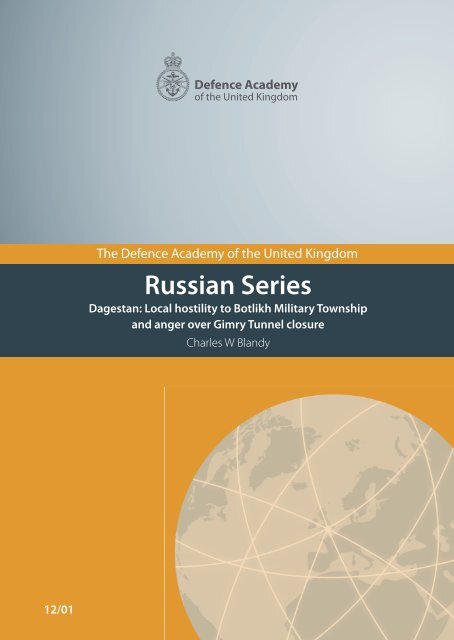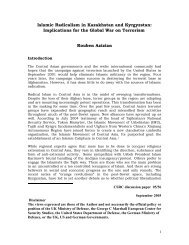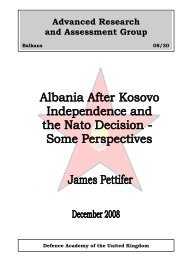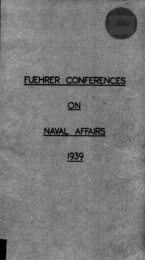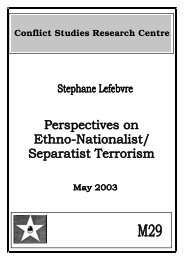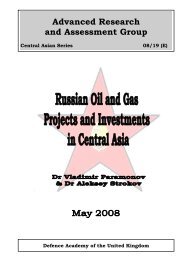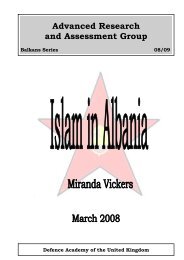Dagestan: Local hostility to Botlikh Military Township and
Dagestan: Local hostility to Botlikh Military Township and
Dagestan: Local hostility to Botlikh Military Township and
Create successful ePaper yourself
Turn your PDF publications into a flip-book with our unique Google optimized e-Paper software.
12/01<br />
The Defence Academy of the United Kingdom<br />
Russian Series<br />
<strong>Dagestan</strong>: <strong>Local</strong> <strong>hostility</strong> <strong>to</strong> <strong>Botlikh</strong> <strong>Military</strong> <strong>Township</strong><br />
<strong>and</strong> anger over Gimry Tunnel closure<br />
Charles W Bl<strong>and</strong>y
<strong>Dagestan</strong>: <strong>Local</strong> <strong>hostility</strong> <strong>to</strong> <strong>Botlikh</strong> <strong>Military</strong> <strong>Township</strong><br />
<strong>and</strong> anger over the Gimry Tunnel closure<br />
Charles W Bl<strong>and</strong>y<br />
Key Findings<br />
• Corruption is the principal problem for Russia <strong>and</strong> <strong>Dagestan</strong><br />
• Corruption in <strong>Dagestan</strong> is having a negative effect on education<br />
• The adaptation process of young people from the “Forest” needs accelerating<br />
in <strong>Dagestan</strong><br />
• Behaviour of Law Enforcement Organs needs improvement in relation <strong>to</strong> the<br />
local population<br />
• The possibility exists that Ramzan Kadyrov, head of Chechnya, would like <strong>to</strong><br />
have use of the <strong>Botlikh</strong> <strong>Military</strong> <strong>Township</strong><br />
• The newly vacated <strong>Botlikh</strong> <strong>Military</strong> <strong>Township</strong> needs thought as <strong>to</strong> its use by the<br />
<strong>Dagestan</strong> government in conjunction with the <strong>Botlikh</strong> rayon administration <strong>and</strong><br />
<strong>Botlikh</strong> Village Council<br />
• The Gimry Tunnel needs <strong>to</strong> be properly controlled <strong>and</strong> answerable <strong>to</strong> the needs<br />
of the Gortsy residents in Mountainous <strong>Dagestan</strong><br />
i
ii<br />
Contents<br />
Map 1 – Southern Federal District <strong>and</strong> North Caucasus Federal District 1<br />
Map 2 - <strong>Dagestan</strong> – District (Rayon) Locations 2<br />
Introduction 3<br />
Creation of North Caucasus Federal District (NCFD)<br />
Formation of Southern <strong>Military</strong> District (SMD)<br />
Background Major Fac<strong>to</strong>rs Affecting Ordinary People in <strong>Dagestan</strong> 5<br />
Governance <strong>and</strong> Corruption<br />
Religion <strong>and</strong> Tyranny of Law Enforcement Organs<br />
<strong>Dagestan</strong> – Security Situation 2 February 2012 7<br />
<strong>Botlikh</strong> – Deployment of <strong>Military</strong> Formation 10<br />
Background <strong>to</strong> Establishment of Fortresses in North Caucasus<br />
“Invasion” of Avaristan in August 1999<br />
Actions of Vladimir Putin as Prime Minister<br />
President Putin – Continued Border Security Concerns<br />
Justification for a Federal <strong>Military</strong> Presence<br />
Border Security Concerns<br />
Requirement for Training Area<br />
Construction of <strong>Botlikh</strong> <strong>Military</strong> <strong>Township</strong> <strong>and</strong> <strong>Local</strong> Reaction<br />
Redeployment of 33 Separate Mo<strong>to</strong>r Rifle Brigade (Mountain) 22<br />
Reasons for Redeployment of 33 (Sep) MR Bde (Mtn)<br />
Anger over Prolonged Closure of Gimry Tunnel 25<br />
Background <strong>to</strong> Village of Gimry<br />
The Gimry Tunnel<br />
Conclusions 27
Map 1 – Southern Federal District <strong>and</strong> North Caucasus Federal District<br />
Southern Federal District<br />
Krasnodar Terri<strong>to</strong>ry, Ros<strong>to</strong>v Region,<br />
Volgograd Region, Astrakhan Region, Republic of Kalmykia, 1. Republic of Adygeya.<br />
North Caucasus Federal District (Red diagonal hatching) Stavropol’ Terri<strong>to</strong>ry,<br />
2. Republic of Karachayevo-Cherkessia, 3. Republic of Kabardino-Balkaria,<br />
4. Republic of North Ossetia-Alania, 5. Republic of Ingushetia, 6.Republic of Chechnya <strong>and</strong> Republic<br />
of <strong>Dagestan</strong>. (@CWB)<br />
1
2<br />
Map 2 - <strong>Dagestan</strong> – Rayon (District) Locations 1<br />
Rayon<br />
Rayon & Centre Rayon<br />
Rayon & Centre<br />
No.<br />
No.<br />
1 Nogayskiy/Terekli-Mekhteb 22 Kayakentskiy/Kayakent<br />
2 Tarumovskiy/Tarumovka 23 Shamil’skiy/Khebda<br />
3 Kizlyarskiy/Kizlyar 24 Gunibskiy/Gunib<br />
4 Babayur<strong>to</strong>vskiy/Babayurt 25 Tsuntinskiy/Kedero<br />
5 Khasavyur<strong>to</strong>vskiy/ Khasavyurt 26 Tlyaratinsky/Tlyarata<br />
6 Kizilyur<strong>to</strong>vskiy/Kizilyurt 27 Charodinskiy/Charoda<br />
7 Kum<strong>to</strong>rkalinskiy/Korkmaskala 28 Lakskiy/Kumukh<br />
8 Under Makhachkala 29 Akushinskiy/Akusha<br />
9 Novolakskiy/Novolakskoye 30 Dakhadayevskiy/Ukurakh<br />
10 Kazbekovskiy/Dylym 31 Kaytagskiy/Madzhalis<br />
11 Buinakskiy/Buinaksk 32 Derbentskiy/Derbent<br />
12 <strong>Botlikh</strong>skiy/<strong>Botlikh</strong> 33 Kulinskiy/Vachi<br />
13 Gumbe<strong>to</strong>vskiy/Mekhelta 34 Tabarsaranskiy/Khuchni<br />
14 Untsukul’skiy/Untsukul’ 35 Rutul’skiy/Rutul<br />
15 Karabudakhentskiy/Karabudakent 36 Agul’skiy/Tpig<br />
16 Tsumadinskiy/Agvali 37 Khivskiy/Khiv<br />
17 Akhvaskiy/Karata 38 Kurakhskiy/Kurakh<br />
18 Khunzakhskiy/Khunzakh 39 Suleiman-Stal’skiy/Kasumkent<br />
19 Gergebil’skiy/Gergebi’l 40 Magaramkentskiy/Magaramkent<br />
20 Levashinskiy/Levashi 41 Akhtinskiy/Akhty<br />
21 Sergokalinskiy/Sergokala 42 Dokuzparinskiy/Uskhchay<br />
1 Respublika <strong>Dagestan</strong> 1:500 000, (Moskva: Roskar<strong>to</strong>grafiya, 1995). Central, western mountainous<br />
Districts 9, 10, 12, 13, 14, 17, 18 <strong>and</strong> 25 from map above marked in heavy red type. (@CWB)
<strong>Dagestan</strong>:<br />
local <strong>hostility</strong> <strong>to</strong> <strong>Botlikh</strong> <strong>Military</strong> <strong>Township</strong><br />
<strong>and</strong> anger over Gimry Tunnel Closure<br />
C W Bl<strong>and</strong>y<br />
“There are a number of fundamental characteristics of foreign <strong>and</strong> domestic policies of any country,<br />
which permit a prediction of its future. In particular, Russia's new year began with a sharp increase in<br />
salary for the security forces. Now junior officers in the army <strong>and</strong> the police receive an average of 50<br />
<strong>to</strong> 100 thous<strong>and</strong> roubles. And this is despite the fact that doc<strong>to</strong>rs <strong>and</strong> teachers are forced <strong>to</strong> settle for<br />
the monthly sum of a derisory 4-6 thous<strong>and</strong> roubles. Experts believe that this imbalance is explained<br />
by the Kremlin's insurance policy against future economic <strong>and</strong> other shocks, when any protest can be<br />
suppressed by force. There is also a version that, in fact, nothing new is happening, because the<br />
whole his<strong>to</strong>ry of Russia – the continual militarisation <strong>and</strong> violence, when the life of its subjects has not<br />
been the normal natural laws of development, <strong>and</strong> force where only the king (General Secretary,<br />
President, l<strong>and</strong>owner, the chief) decide <strong>to</strong> whom <strong>to</strong> give freedom, <strong>and</strong> whom - <strong>to</strong> punish. And if the<br />
average Russian <strong>to</strong>day, these threats are somewhat abstract in nature, life of <strong>Dagestan</strong> is an<br />
increasingly regulated power component.” 2<br />
Introduction<br />
The purpose of this paper is <strong>to</strong> examine continuing local <strong>hostility</strong> <strong>to</strong>ward the earlier construction of a<br />
military <strong>to</strong>wnship at <strong>Botlikh</strong> for a mo<strong>to</strong>r rifle brigade, the formation’s abrupt redeployment <strong>to</strong> the<br />
western North Caucasus, somewhat surprising after the expenditure of 14 billion roubles (R) on<br />
building the <strong>to</strong>wnship in the first instance, <strong>and</strong> the wider scale of anger directed at the continued<br />
closure of the Gimry vehicle tunnel.<br />
Before focusing on the specific points concerning <strong>Botlikh</strong> <strong>and</strong> the Gimry tunnel, there is a need <strong>to</strong> note<br />
the major changes affecting the system of regional government in Southern Russia <strong>and</strong> the North<br />
Caucasus, as well as the reorganisation of the military comm<strong>and</strong> structure. It is also important <strong>to</strong> be<br />
aware of some general fac<strong>to</strong>rs affecting the lives of ordinary people in <strong>Dagestan</strong>, in particular, the<br />
importance of the short extract above from an article by Akhmednabi Akhmednabiyev, a journalist at<br />
the <strong>Dagestan</strong>i weekly newspaper Ndelo.<br />
With regard <strong>to</strong> the degree of permanent military support based in <strong>Dagestan</strong>, this matter requires an<br />
astute, intelligent assessment bearing in mind that in the past, there was not only his<strong>to</strong>rical evidence<br />
of complacency by St Petersburg during the Long Caucasus War in Tsarist times, 3 but also in more<br />
recent times with the Chechen ‘invasion’ in August 1999, 4 <strong>and</strong> the fact that since the summer of 2011:<br />
<strong>Dagestan</strong> continues <strong>to</strong> remain the most turbulent region of the North Caucasus. The high<br />
activity of the underground here is combined with a whole multitude of social, religious <strong>and</strong><br />
ethnic conflicts, which have penetrated <strong>Dagestan</strong>i society at all levels. The consequences of a<br />
mass spread of firearms amongst the population, many quarrels – l<strong>and</strong>, inter-ethnic, interconfessional<br />
<strong>and</strong> simply everyday life – often end in shooting with human casualties. 5<br />
2 Akhmednabi Akhmednabiyev, ‘<strong>Dagestan</strong> Terri<strong>to</strong>riya spetsoperatsii?’, Ndelo, Vypysk No 5 (1044), 10<br />
February, www.ndelo.ru/one_stat.php?id=6363.<br />
3 Moshe Gammer Muslim Resistance <strong>to</strong> The Tsar: Shamil <strong>and</strong> the Conquest of Chechnia <strong>and</strong><br />
<strong>Dagestan</strong>, (London: Frank Cass & Co Ltd, 1994), pp. 139 <strong>and</strong> 149.<br />
4 C W Bl<strong>and</strong>y ‘Chechnya: Two Federal Interventions – An Interim Assessment’, CSRC P29, January<br />
2000 p. 32.<br />
5 ‘Pravozashchitnikov tsentr Memorial Situatsiya v zonye konflikta na Severnom Kavkazye: Otsenka<br />
pravozashchitnikov. Le<strong>to</strong> 2011’. ‘Polozheniye v <strong>Dagestan</strong>iye’, Kavkaz-Uzel, http://www.kavkazuzel.ru/articles/194174/#6<br />
3
Creation of the North Caucasus Federal District (NCFD)<br />
On 19 January 2010, President Dmitriy Medvedev increased the number of federal districts from<br />
seven <strong>to</strong> eight. Map One (above) shows the comparatively new North Caucasus Federal District<br />
(NCFD, Severo-Kavkazskiy Okrug (SKFO)) marked by red hatching, containing the republics of<br />
<strong>Dagestan</strong>, Karachayevo-Cherkessia, Kabardino-Balkaria, North Ossetia-Alania, Ingushetia <strong>and</strong><br />
Chechnya, which were detached from the Southern Federal District (SFD, Yuzhniy Federal’niy Okrug<br />
(YuFO)). 6 The NCFD is based in Pyatigorsk in Stavropol’ kray.<br />
President Medvedev also announced the appointment of Aleks<strong>and</strong>r Khloponin, a former governor of<br />
Krasnoyarskiy kray, as his plenipotentiary representative <strong>to</strong> the new federal district. At a meeting with<br />
Khloponin, President Medvedev recalled that the main problems prevalent in the North Caucasus<br />
were “mass unemployment, criminality, clan power, corruption. To eradicate all this, not only forceful,<br />
but economic methods are envisaged”. 7<br />
The Republic of Adygeya remains within the Southern Federal District (SFD), although it would have<br />
appeared more logical <strong>to</strong> have included the republic within the NCFD, due <strong>to</strong> its close ethnic ties, with<br />
the Republics of Karachayevo-Cherkessia <strong>and</strong> Kabardino-Balkaria. Following the announcement of<br />
the decree, the youth movement “Adygye Khase of Karachayev-Cherkessia” asked the federal centre<br />
<strong>to</strong> reconsider its decision. Whilst the youth movement regarded the separation of the North Caucasus<br />
republics <strong>and</strong> Stavropol’ kray in<strong>to</strong> a separate federal district as a positive fac<strong>to</strong>r, their members were<br />
concerned that the Cherkess (Adygskiye) republics had now been placed in two separate federal<br />
districts. Moreover, the Cherkess (Adygi) were now artificially divided in<strong>to</strong> three republics: Adygeya,<br />
Karachayevo-Cherkessia (KChR) <strong>and</strong> Kabardino-Balkaria (KBR), “which are now split between<br />
different federal districts, <strong>and</strong> we consider this <strong>to</strong> be completely unacceptable”. 8<br />
Nevertheless, as Mairbek Vatchagaev pointed out, with only two years before the 2014 Winter<br />
Olympics in Sochi tensions are bound <strong>to</strong> increase in the western part of the North Caucasus. 9<br />
Formation of the Southern <strong>Military</strong> District (SMD)<br />
In addition <strong>to</strong> the regional government changes mentioned above, it was announced on 21 September<br />
2010 that President Medvedev had signed a decree “Concerning the military-administrative division of<br />
the Russian Federation” 10 which introduced an updated pan-Russia military comm<strong>and</strong> <strong>and</strong> terri<strong>to</strong>rial<br />
structure for the Armed Forces. The number of military districts was reduced from six <strong>to</strong> four, resulting<br />
in four combined strategic directions (Ob’edinenniye strategichiskiye kom<strong>and</strong>ovanniye (OSK)), namely<br />
“West”, “South”, “Centre” <strong>and</strong> “East”.<br />
The former North Caucasus <strong>Military</strong> District (NCMD) was upgraded <strong>to</strong> become the more powerful<br />
Southern <strong>Military</strong> District (SMD), with effect from 4 Oc<strong>to</strong>ber 2010 based at the headquarters at Ros<strong>to</strong>von-Don.<br />
11 The combat potential of SMD was estimated <strong>to</strong> be some “50-200 %” greater than that of<br />
the former NCMD. The Black Sea Fleet (BSF) <strong>and</strong> Caspian Flotilla are subordinated <strong>to</strong> the SMD<br />
headquarters in Ros<strong>to</strong>v. 12 It was also interesting <strong>to</strong> note that the SMD in terms of terri<strong>to</strong>rial area is the<br />
smallest, but in terms of troop density it has the highest concentration of military forces in the Russian<br />
6 Yelena Denisova, ‘President naznachil svoyego predstavitelya na Severnyy Kavkaz’, 20 January<br />
2010, http://www.smi.ru/10/01/20/909796549.html<br />
7 Ibid.<br />
8 ‘Cherkesskaya molodezh’ prochil vklyuchit’ Adygeyu v SKFO’, Kavkaz-Uzel, 24 January 2010,<br />
http://www.kavkaz-uzel.ru/articles/164602/<br />
9 Mairbek Vatchagaev, ‘What Russian Statistics On Militant Attacks In the North Caucasus Reveal’,<br />
Eurasia Daily Moni<strong>to</strong>r Vol 8, Issue 224, December 9 2011, para 8,<br />
http://www.james<strong>to</strong>wn.org/single/?no_cache=1&tx_ttnews%5Btt_news%5D=38760&tx_ttnews%5Bbac<br />
kPid%5D=7&cHash=49995d423be7ab73b7a363ba1971732f<br />
10 ‘C 1 Dekabrya v Rossii budet chetyrye voyennykh okrugakh’, Kommersant-Online, 21 September<br />
2010, http://www.kommersant.ru/doc.aspx?DocsID=1508004&NodesID=7<br />
11 Yuri Gavrilov, ‘Doubling Force’, Rossiyskaya Gazeta, Oc<strong>to</strong>ber 05 2010, p. 2.<br />
12 ‘Formation of the Southern <strong>Military</strong> District was completed’, Gazeta, Oc<strong>to</strong>ber 04 2010, p. EV.<br />
4
Federation. 13 With the creation of Strategic Directions (OSK) a further division of functions between<br />
the General Staff, High Comm<strong>and</strong>s, district comm<strong>and</strong>ers <strong>and</strong> army structures has been effected.<br />
Background - Major Fac<strong>to</strong>rs Affecting Ordinary People in <strong>Dagestan</strong><br />
Governance <strong>and</strong> Corruption<br />
There are at least four main interconnecting fac<strong>to</strong>rs which contribute <strong>to</strong> instability in the republic. First,<br />
the system of republic government in <strong>Dagestan</strong> based on titular nationalities, designed <strong>to</strong> cope with<br />
the wide ethnic diversity in the republic <strong>and</strong> reduce inter-ethnic strife, has tended <strong>to</strong> foster clan<br />
corruption (further details on government structure are at Appendix One). A second fac<strong>to</strong>r is the very<br />
scale of corruption itself, mentioned in an article by Akhmednabi Akhmenabiyev in Ndelo on 14<br />
Oc<strong>to</strong>ber 2011, which stated that:<br />
Problem No 1 for Russia <strong>and</strong> <strong>Dagestan</strong> is corruption. The whole life of an individual in a direct<br />
sense is penetrated by this defect: birth requires a bribe when a person is born, when the time<br />
of death comes it is necessary <strong>to</strong> pay at the mortuary. It seems the most frightening thing:<br />
<strong>to</strong>day the state is maintained on the foundations of corruption. 14<br />
Akhmenabiyev’s article also included the views of a businessman who argued:<br />
It is possible <strong>to</strong> solve any problem by bribery. Likewise, it is possible <strong>to</strong> purchase any position.<br />
Everything depends on the size of the purse. Personally, the matter that most concerned me<br />
was the situation with the law enforcement organs. Today the structure is being turned in<strong>to</strong> a<br />
continuous market of corruption. Of course it is true that honest employees also work there,<br />
but they don’t make the weather. 15<br />
A deeper, longer term aspect of corruption in <strong>Dagestan</strong>, which has been condemned by Enver<br />
Kisriyev, results from the clan system [see Appendix]: talented young people from poor families are<br />
denied the opportunity <strong>to</strong> benefit from higher education due <strong>to</strong> their inability <strong>to</strong> find the money <strong>to</strong><br />
‘secure’ a place. Without higher education they are unable <strong>to</strong> obtain good employment <strong>and</strong> become a<br />
respected person in society. 16 Kisriyev maintains that when a person drops out of a social context, he<br />
is not able <strong>to</strong> find a place in society, with the result that he develops hatred <strong>to</strong>wards the regime, as<br />
well as despair, <strong>and</strong> searches for a justification <strong>to</strong> fulfil his desire <strong>to</strong> fight against the existing system.<br />
They may turn <strong>to</strong> more extreme measures, especially when there appears <strong>to</strong> be no other way out,<br />
particularly when the unemployed person loafing around in the street becomes of interest <strong>to</strong> law<br />
enforcement organs. 17 It is no surprise that young unemployed people seek <strong>to</strong> join the ‘forest’<br />
brothers, 18 or a jamaat or religious community. This brings us <strong>to</strong> the third fac<strong>to</strong>r, namely the question<br />
of religion, <strong>and</strong> fourth, the tyranny of law enforcement organs.<br />
Religion <strong>and</strong> Tyranny of Law Enforcement Organs<br />
As Kisriyev stated with reference <strong>to</strong> religion in <strong>Dagestan</strong>, conceptually there are two str<strong>and</strong>s of Islam.<br />
The first is contemporary traditional Islam, sometimes known as the tarikat. At the head of the Spiritual<br />
Direc<strong>to</strong>rate of Muslims of <strong>Dagestan</strong> (Dukhovnoye Upravleniye Musul’man <strong>Dagestan</strong>a (DUMD)) are<br />
Sufi sheikhs assisted by murids. 19 DUMD is the official organ of the Muslim religion in <strong>Dagestan</strong>. The<br />
‘other’ form of Islam, the Salafity (Wahhabity) are based in jamaats, local villages or communities of<br />
like-minded people. This form of Islam does not have priests because they believe that no person can<br />
13 Sergey Konovalov, ‘Obnovlennaya oborona Severnogo Kavkaza – Generaly otlichitalis’ o<br />
prakticheski polnom perevooruzhenii voysk v regione’, Nezavisimoye Voyennoye Obozreniye, 25<br />
Oc<strong>to</strong>ber 2011, http://www.ng.ru/nvo/2011-10-25/6_kavkaz.html<br />
14 Akhmednabi Akhmenabiyev, ‘Proizgrannaya voyna’, Ndelo, Issue No 40 (1028) 14 Oc<strong>to</strong>ber 2011,<br />
http://www.ndelo.ru/one_stat.php?id=5741, p. 1.<br />
15 Ibid., p. 1.<br />
16 Enver Kisriyev, ‘Klanovaya sistema porozhdayet lyudey, obrechennukh na gibel’ i sozdayushchikh<br />
massu problem dliya Obshchestva’, Kavkaz-Uzel, 13 August 2010, http://dagestan.kavkazuzel.ru/articles/172950,<br />
pp. 2 & 3.<br />
17 Ibid., p. 2.<br />
18 Ibid., p. 2.<br />
19 Ibid., p. 2.<br />
5
serve as a substitute for Allah. Furthermore, because of the apparently close links between the<br />
government <strong>and</strong> DUMD, the fact that official Islam appears <strong>to</strong> turn a blind eye <strong>to</strong>, or is implicit in,<br />
endemic corruption, the disappointed, rebuffed young seek a simpler path for their religious<br />
observance. In Kisriyev’s view:<br />
6<br />
The reason for the armed struggle of Islamic extremists against the government lies not in a<br />
religious, but in a social-economic space: inhabitants of <strong>Dagestan</strong> au<strong>to</strong>matically become<br />
enemies of the regime if they take the path of ideological dissidence, while the republic’s<br />
authorities do not maintain a position of neutrality in the resolution of religious questions. 20<br />
Complaints over the “tyranny” of law enforcement organs resonated at a well-attended public meeting<br />
in Makhachkala at the end of 2011:<br />
Today Muslims are arrested, beaten, killed. We dem<strong>and</strong> that this lawlessness is terminated.<br />
We are at a critical point. . . . . all these abductions were being carried out by law enforcement<br />
special detachments. 21<br />
Why was the lawlessness of members of the power structures in the region continuing <strong>and</strong><br />
who shouldered responsibility for this lack of control? 22<br />
An article by Konovalov in Nezavisimaya Gazeta on 2 November 2011 reflected Kisriyev’s arguments<br />
about why young people in <strong>Dagestan</strong> join the ‘forest’ brothers. Based on the result of a survey (see<br />
Table Three) investigating the motivations of those who join insurgent groups, it concluded that the<br />
majority of respondents believe the extreme brutality of law enforcement organs in the republic is a<br />
key fac<strong>to</strong>r (although it was also noted that insurgent groups behave in a similarly brutal manner). <strong>Local</strong><br />
journalist Nadir Isayev notes that those who move ‘<strong>to</strong> the forest’ (i.e. join the insurgents) are<br />
predominantly those born in the 1980s <strong>and</strong> 1990s, i.e. 21 <strong>to</strong> 31 year olds. 23<br />
Table Three – Reasons for Movement <strong>to</strong> Forests 24<br />
Reason Percentage<br />
Due <strong>to</strong> Law Enforcement Organs 49.4<br />
Religious Conviction 28.3<br />
Unemployment 20.8<br />
No particular reason 1.0<br />
It should come as no surprise that the leader of the ‘Caucasus Emirate’, Dokku Umarov, capitalised on<br />
the unpopularity of law enforcement agencies, announcing changes with regard <strong>to</strong> those members of<br />
the Russian civilian population who would no longer be targeted. 25 Umarov spoke about the new<br />
changes in a video broadcast from one of the sites which supported the boyeviki (see Box One).<br />
20 Ibid., p. 3.<br />
21 Murad Muradov, ‘Dokhodim do kriticheskoy <strong>to</strong>chki’, Ndelo, Vypusk No 46 (1034) 29 November<br />
2011, http://www.ndelo.ru/one_stat.php?id=5987, p. 1.<br />
22 Den’ga Khalidov, ‘Eri v koren’, Ndelo, Vypusk No 48 (1036) 9 December 2011,<br />
http://www.ndelo.ru/one_stat.php?id=6049<br />
23 Sergey Konovalov, ‘Неудобная социология терроризма в Дагестане Произвол силовиков,<br />
радикальные религиозные убеждения и массовая безработица’, Nezavisimaya Gazeta, 2<br />
November 2011, http://www.ng.ru/regions/2011-11-02/1_dagestan.html, p. 1. In response <strong>to</strong> the<br />
question “Why, in your view, do <strong>Dagestan</strong>is go off <strong>to</strong> the forests?”, some 2,117 people aged between<br />
18 <strong>to</strong> 80 years participated in the survey.<br />
24 Op. cit. Sergey Konovalov<br />
25 ‘Umarov prikazal boyevikam na Kavkazye izbegat’ atak na mirnyye tseli’, Kavkav-Uzel, 3 February<br />
2012, http://www.kavkaz-uzel.ru/articles/200452/
Box One – Extract from Dokuu Umarov Video <strong>and</strong> Comment by Rabbi Shmulevich 26<br />
In the video, the leader of the ‘Caucasus Emirate’ says that Russia has begun the process of civil<br />
protest, <strong>and</strong> the population, according <strong>to</strong> him, no longer accepts Putin's policies, which may mean<br />
that it does not support the methods of waging war in the Caucasus, which Putin authorized. At the<br />
same time Umarov says, in opposing the current government of the Russian Federation, citizens<br />
[will] protect themselves from attack by militants. The militant leader has ordered his men <strong>to</strong> attack<br />
the terri<strong>to</strong>ry of Russia by accurately pinpointing <strong>and</strong> selectively targeting security forces, the army,<br />
intelligence services <strong>and</strong> political leadership of the country. Rabbi Abraham Shmulevich head of the<br />
Institute Eastern Partnership, wrote in his blog "Live Journal" that Islamist terrorist attacks only<br />
contributed <strong>to</strong> the growth of anti-Caucasian <strong>and</strong> anti-Muslim sentiment among Russians with a<br />
substantial boost in support for the Prime Minister Vladimir Putin. In changing strategy, Shmulevich<br />
is convinced, it not only opens the way for the militants <strong>to</strong> build relations with politicians in the West,<br />
it also removes one of the Kremlin's main pillars of legitimacy in the eyes of the population.<br />
<strong>Dagestan</strong> - Security Situation 2 February 2012<br />
Underlining the seriousness of the situation facing the government <strong>and</strong> authorities in <strong>Dagestan</strong>, at the<br />
beginning of 2012 the <strong>Dagestan</strong> Coordination Committee under the chairmanship of the <strong>Dagestan</strong><br />
Republic’s President Magomedsalam Magomedov reviewed the security situation in the republic. This<br />
resulted in additional security measures, namely five mobile operational groups composed of Internal<br />
Troops MVD, FSB <strong>and</strong> MOD servicemen. The groups were <strong>to</strong> be dispatched <strong>to</strong> the rayony where<br />
insurgent activity was highest: Derbentskiy (32), Kiziliyur<strong>to</strong>vskiy (3), Tsumadindinskiy (21),<br />
Untsukul’skiy (14) <strong>and</strong> Sergokalinskiy (16). 27<br />
In the summer-autumn of 2010 the new president of <strong>Dagestan</strong>, Magomedsalam Magomedov<br />
proposed the formation of MVD Internal Troops (VV) special subunits formed from local <strong>Dagestan</strong>i<br />
residents <strong>to</strong> prosecute the campaign against the boyeviki, a campaign which had been largely<br />
ineffective. As Magomedov explained, countering well-prepared, trained <strong>and</strong> intelligent armed b<strong>and</strong>its<br />
required superior skills, weaponry <strong>and</strong> equipment, with specially trained subunits, capable of operating<br />
in forest <strong>and</strong> mountainous terrain. Magomedov also added that such personnel should have strict a<br />
moral <strong>and</strong> material motivation for the successful neutralisation of illegal b<strong>and</strong>it formations,<br />
emphasising that “[e]very metre of <strong>Dagestan</strong>i l<strong>and</strong> must burn under the feet of b<strong>and</strong>its, wherever they<br />
are situated – in forests, in the mountains, in <strong>to</strong>wns <strong>and</strong> villages”. 28<br />
26 ‘Umarov prikazal boyevikam na Kavkazye izbegat’ atak na mirnyye tseli’, Kavkav-Uzel, 3 February<br />
2012, http://www.kavkaz-uzel.ru/articles/200452/<br />
27 ‘V <strong>Dagestan</strong>ye opredelili rayony maksimal’noy aktivnosti boyevikov’, Lenta.ru, 08.02.12,<br />
http://lenta.ru/news/2012/02/02/hotspots<br />
28. Akhmednabi Akhmednaabiyev, ‘<strong>Dagestan</strong> – Terri<strong>to</strong>riya spetsoperatsiy’ Ndelo, Vypusk No 5 (1044)<br />
10 February 2012, http://www.ndelo.ru/one_stat.php?id=6363<br />
7
8<br />
Box Two – Security Forces Available <strong>to</strong> <strong>Dagestan</strong> against Armed Underground 29<br />
<strong>Dagestan</strong>: MVD (inc. SOBR, OMON) approx 20,000 men (Makhachkala: 102 Bde MVD VV,<br />
136 MR Bde Buynaksk, 99 Gds Bde MP Kaspiysk (in all some 10,000 men)? Subunits of mobile<br />
detachment MVD Russia; comm<strong>and</strong> of servicemen of different special services 500 men. At disposal<br />
of operational headquarters approx 3,000 men. FSB Russia (Dag) 1,500 men plus. Within the<br />
structure is a spetnaz subunit of FSB “Al’fa”, within the zone of responsibility belonging <strong>to</strong> NCFD.<br />
Since March 2007 on the outskirts of Makhachkala (Caucasus court) a special training centre FSB<br />
Russia in <strong>Dagestan</strong> which could take up <strong>to</strong> 1,000 people. Total some 57,000 people with MVD<br />
<strong>Dagestan</strong><br />
Chechnya: MVD: around 16,000 men: Regt Oil/Gas external protection Regt 3,000 men, Spetsnaz<br />
regt 2,000 men; two separate patrol/VP guard regts plus the Akhmed Kadarov Regt (500 men) in all<br />
3,000 men. In Btns (Sever) <strong>and</strong> (Yug) of 46 Div MVD Russia – 2,000 men, two spetsnaz coys from<br />
former 42 MRD – 500 men; At permanent readiness 42 MRD (15,000 men), 46 Sep Bde MVD VV -<br />
15,000 men, in mtn terrain FPS FSB 1,000 men. FSB has around 3,000 men with 500 allotted <strong>to</strong><br />
counter-intelligence. From both Republics some 118,000 men representing the power structures<br />
could be mustered.<br />
The operations involving the five mobile operational groups composed of MVD, FSB, MVD servicemen<br />
in Derbentskiy, Kiziliyur<strong>to</strong>vskiy, Tsumadindinskiy, Untsukul’skiy <strong>and</strong> Sergokalinskiy rayony were<br />
somewhat overshadowed by a major operation on the Checheno-<strong>Dagestan</strong> border in the area of<br />
<strong>Dagestan</strong>’s Kazbekovskiy rayon over the period 13-18 February 2012 (see Box Three).<br />
Box Three – Outline of Checheno-<strong>Dagestan</strong> Border Operation 13-18 February 2012 30<br />
Over four days the special operation on the Checheno-<strong>Dagestan</strong> border resulted in 17 members of<br />
the law enforcement forces being killed, with 24 policemen injured.<br />
13 Feb 12: The border operation started on the evening of 13 February when boyeviki fired at the<br />
police. The operation was initiated in the Nozhay-Yur<strong>to</strong>vskiy rayon in Chechnya <strong>and</strong><br />
then crossed over in<strong>to</strong> Kazbekovskiy rayon of <strong>Dagestan</strong>.<br />
14 Feb 12: Servicemen from the power structures started the special operation. However, there was<br />
no news of casualties by Saturday evening.<br />
16 Feb 12: Three b<strong>and</strong>it groups were surrounded, numbering some dozens of men, <strong>and</strong> on the<br />
following day the leader of Chechnya Ramzan Kadyrov announced that one of the b<strong>and</strong>it groups had<br />
been liquidated. Its leader was a 47 year-old Chechen, Magarbi Timeraliyev, known as Abudar or<br />
Makharbi. All the casualties <strong>and</strong> relatives killed in the special operation received material<br />
compensation from the charitable fund named after Akhmad Kadyrov.<br />
17 Feb 12: A source from Interfax reported that 11 – 13 policemen had been killed in the clashes<br />
with the boyeviki.<br />
18 Feb 12: MVD Chechnya numbered the casualties amongst members of the law enforcement<br />
organs. Over the four days of the special operation 17 members of the law enforcement organs had<br />
been killed with the police sustaining light or medium wounds.<br />
A summary of a later report from Lenta.ru on the operation on the Checheno-<strong>Dagestan</strong> border will<br />
have given little comfort <strong>to</strong> Aleks<strong>and</strong>r Khloponin, the Presidential plenipotentiary representative <strong>to</strong> the<br />
NCFD at Pyartigorsk, the MVD <strong>and</strong> SMD, particularly the last sentence:<br />
In two border rayony of Chechnya <strong>and</strong> <strong>Dagestan</strong> a battle continued the whole of last week<br />
between MVD subunits of the two republics <strong>and</strong> three b<strong>and</strong>it formations numbering several<br />
dozens of people. The outcome was disturbing: police casualties – more than 40 men killed or<br />
wounded. One insurgent b<strong>and</strong> of 20 was destroyed. The remainder have dispersed <strong>to</strong> the<br />
29. Ibid., Akhmednabi Akhmednaabiyev, Ndelo, 10 February 2012.<br />
30. ‘MVD Chechni pereschitalo pogibshikh na granitse s <strong>Dagestan</strong>om’,<br />
http://lenta.ru/news/2012/02/18/chchn/
mountains <strong>and</strong> forests…The scale of the armed clash has not been seen in the last few<br />
years either on the terri<strong>to</strong>ry of Chechnya or throughout the North Caucasus. 31<br />
The Chechen leader Ramzan Kadyrov announced on 17 February that many subunits of the Chechen<br />
power structures had surrounded, blocked <strong>and</strong> annihilated Magarbi Timiraliyev’s b<strong>and</strong>it group, killing<br />
seven boyeviki. The spetsoperation against Timiraliyev’s b<strong>and</strong> which began in thick forestedmountain<br />
terrain of the high mountain rayon of Nozhay-Yurt “was concluded in the Kazbekovskiy<br />
rayon of <strong>Dagestan</strong>”. 32 Meanwhile certain inconsistencies concerning the deaths of the boyeviki<br />
appeared on the Chechen leadership’s website. 33 There were reports that the counter-terrorist<br />
operation being concluded in <strong>Dagestan</strong>’s Kazbekovskiy rayon had aroused concerns from the<br />
<strong>Dagestan</strong>i side. Moreover, according <strong>to</strong> Akhmed Magomedov in his article on 20 February in Kavkaz-<br />
Uzel, Ramzan Kadyrov had also <strong>to</strong>ld journalists that “from this year the governments of both republics<br />
between them have discussed joint actions against the armed underground”. 34 However, the<br />
<strong>Dagestan</strong>i view was that “the behaviour of people from Chechen power structures could spoil the<br />
cooperation of two brotherly republics.” 35 Den’ga Khalidov, a member of the Russian Congress of<br />
Caucasus Peoples <strong>and</strong> publicist considered that:<br />
Chechens from the power structures have no role <strong>to</strong> play in <strong>Dagestan</strong>. The republic has its<br />
own forces. Even if <strong>to</strong>day there were certain advantages, although personally I have my<br />
doubts about this, in a strategic plan there will be a worsening of relations between brotherly<br />
peoples. A decade later no one will underst<strong>and</strong> why the Chechens came <strong>to</strong> <strong>Dagestan</strong>, they<br />
will analyse this fact purely from the negative side. 36<br />
The publicist <strong>and</strong> poet Adallo expressed himself in more categorical terms, stating that the local<br />
government must learn <strong>to</strong> speak with the boyeviki: “I heard…how one of the North Caucasus leaders<br />
went <strong>to</strong> the boyeviki himself <strong>to</strong> convince them <strong>to</strong> return <strong>to</strong> a peaceful life. But the <strong>Dagestan</strong><br />
government sits in comfortable offices <strong>and</strong> relaxes at resorts. It’s all the same, with us it will be, the<br />
most important thing – keep the armchair.” 37<br />
Perhaps the absence of a permanent federal military presence at <strong>Botlikh</strong>, following the redeployment<br />
of 33 Mo<strong>to</strong>r Rifle Brigade (Mountain), rekindles earlier memories of the Chechen invasion headed by<br />
Shamil’ Basayev <strong>and</strong> Emir Khattab in August 1999, as well as fears about Kadyrov’s ambitious<br />
dreams, a nightmare for the Avars <strong>and</strong> other <strong>Dagestan</strong>is living along the border:<br />
Remember, before the beginning of the war in 1999, practically all the troop formations were<br />
transferred out of <strong>Dagestan</strong>. Similarly, in Moscow the ‘hawks’ win again, who dream of<br />
igniting the fire of a civil war in the republic. Today they move the mountain riflemen out,<br />
<strong>to</strong>morrow the turn of others will come, next a full-scale war. There is a belief that the military<br />
<strong>to</strong>wnship could be transferred <strong>to</strong> special subunits, subordinated <strong>to</strong> the Chechen president<br />
Ramzan Kadyrov. They will take part in all special operations in Mountainous <strong>Dagestan</strong>,<br />
particularly in view of the fact that recent armed clashes in Tsumadinskiy <strong>and</strong> Tsuntinskiy<br />
districts showed the professional unpreparedness of our police. There is yet another variant of<br />
events: the military <strong>to</strong>wnship could actually be transferred <strong>to</strong> be under the full control of district<br />
<strong>and</strong> republic authorities – that would be the very worst option for its future, since for the<br />
maintenance of its infrastructure gigantic funding is required. 38<br />
31. Andrey Kuznetsov, ‘Pogranichnaya Boynya – Na granitse Chechni i <strong>Dagestan</strong>a zavershilos’<br />
masshtabnoye srazheniye’, http://lenta.ru/articles/2012/02/20/border/, p.1.<br />
32 Akhmed Magomedov, ‘Khalidov: Chechenskiye siloviki ne dolzhny uchastvovat’ v spetsoperatiyakh<br />
v <strong>Dagestan</strong>ye’, Kavkaz-Uzel, 20 February 2012, http://dagestan.kavkaz-uzel.ru/articles/201500/<br />
33. Andrey Kuznetsov, ‘Pogranichnaya Boynya – Na granitse Chechni i <strong>Dagestan</strong>a zavershilos’<br />
masshtabnoye srazheniye’, http://lenta.ru/articles/2012/02/20/border/, p.1.<br />
34 Op. cit. Magomedov.<br />
35 Op. cit. Magomedov.<br />
36 Op. cit. Magomedov.<br />
37 Op. cit. Magomedov.<br />
38 Akhmednabi Akhmednabiyev ‘Zavtra budyet Voyna?’, Ndelo, Vypusk No 14 (1002) 15 April 2011,<br />
http://www.ndelo.ru/one_stat.php?id=4672<br />
9
<strong>Botlikh</strong> - Deployment of a <strong>Military</strong> Formation<br />
Background <strong>to</strong> Establishment of Fortresses in North Caucasus<br />
His<strong>to</strong>rically one of the manifestations of Russian imperial power in the 18 th <strong>and</strong> 19 th centuries was the<br />
relentless march of the Caucasus Fortified Lines. The establishment of fortresses along the line of the<br />
River Terek, 39 such as Kizlyarskaya (1739), Mozdokskaya (1763) <strong>and</strong> Groznaya (1817), started “the<br />
creation of a dense chain of cordoned fortresses from the mouth of the Terek <strong>to</strong> the mouth of the<br />
Don”. 40 Additional fortresses were constructed, namely Sunzhenskaya (1817), Labinskaya (1840) <strong>and</strong><br />
later Urupskaya (1850). By the 1830s Tsarism had started <strong>to</strong> create Cossack stanitsy 41 on the<br />
lowl<strong>and</strong>s, where, according <strong>to</strong> E. D. Muzhukhoyeva 42 , between 1838 <strong>and</strong> 1850 the following Cossack<br />
stanitsy were established on the Terek left bank on the Vladikavkaz plain: Ardonskaya (1838)<br />
Nikolayevskaya <strong>and</strong> Vladikavkazskaya (1842), Zmeyskaya (1849), Gorskya (1850) <strong>and</strong> Ardonskaya<br />
(1863), which in turn led <strong>to</strong> the advent of stanitsy on the Sunzhenskaya fortified line. In 1845-1846 the<br />
stanitsy of Sleptsovskaya, Mikhaylovskaya, Troitskaya were established, followed by the stanitsy of<br />
Assinovskaya (1847), Zakan-Yur<strong>to</strong>vskaya (1850), Samashkinskaya <strong>and</strong> Alkhan-Yur<strong>to</strong>vskaya (1851).<br />
Map Three below shows the sheer scale of an all-embracing network of fortresses <strong>and</strong> fortified lines<br />
throughout the North Caucasus during the 18 th <strong>and</strong> 19 th centuries.<br />
39 Bol’shaya Sovetskaya Entsiklopediya, 2 nd Edition, Vol 42, 1956, p. 361.<br />
40. Bol’shaya Sovetskaya Entsiklopediya, 2 nd Edition, Vol 19, 1953, p. 274.<br />
41. Stanitsa : a Cossack village or settlement.<br />
42. E. D. Muzhukhoyeva ‘Checheno-Ingushetiya v Administrativno-Politicheskoy sisteme upravleniya<br />
Terskoy oblasti v 40 – 60 gody XIX Veka’ in Checheno-Ingushetiya v Politicheskoy is<strong>to</strong>rii Rossii i<br />
Kavkaza v dorevolyutsionnom proshlom. A. I. Khasbula<strong>to</strong>v (Edi<strong>to</strong>r-in-Chief), Sh. B. Akhmadov, Ya. Z.<br />
Akhmadov, A. A. Mamkiyev, V. E. Naumenko, (Checheno-Ingushskiy nauchno-issledovatel’skiy institut<br />
is<strong>to</strong>rii, ekonomiki, sotsilogii i filologii) pp. 61-86.<br />
10
Map Three – Caucasus Fortified Lines 43<br />
Whilst the map above concentrates on the areas that were mainly under the control of the Black Sea<br />
<strong>and</strong> Terek Cossacks, Akhmednabiyev notes that in 1859 there was also a precedent not only for the<br />
establishment of a military <strong>to</strong>wnship at <strong>Botlikh</strong>, but also for vast expenditure, followed 20 years later by<br />
the <strong>to</strong>tal ab<strong>and</strong>onment of the fortress:<br />
In 1859 Tsarist Russia constructed the so-called Preobrazhenskaya fortress, over 20 years<br />
later a similar settlement was completed in <strong>Botlikh</strong> itself. Huge sums of money were<br />
expended, but the fate of both structures was similar: every <strong>Dagestan</strong>i can admire their ruins,<br />
the mountain dwellers have long ago taken building materials, only the melancholy wind <strong>and</strong><br />
wild animals rule here now... 44<br />
43 Bol’shaya Sovetskaya Entsiklopediya, 2 nd Edition, Vol 19, 1953, p. 274.<br />
44 Op. cit. Akhmednabiyev, 15 April 2011.<br />
11
Map Four – Nodal Position of <strong>Botlikh</strong><br />
It can be seen from Map Four above that <strong>Botlikh</strong> comm<strong>and</strong>s routes <strong>to</strong> <strong>and</strong> from the North-West via the<br />
Khagal-Sodontsy <strong>and</strong> Karami Passes, as well as in <strong>and</strong> out of Chechnya via Vedeno. <strong>Botlikh</strong><br />
comm<strong>and</strong>s other routes leading south up the Andiskoye Koysu past Agvali <strong>and</strong> Tsumada with many<br />
footpaths, trails <strong>and</strong> minor tracks from Chechnya <strong>and</strong> Georgia joining the Andi-Koysu river line from<br />
the west. <strong>Botlikh</strong> also comm<strong>and</strong>s the route <strong>to</strong> Muni, Tlokh, Gimry via the Erpeli-Gimry tunnel <strong>to</strong><br />
Buynaksk, <strong>and</strong> was a point on Chechen resupply routes <strong>to</strong> Z<strong>and</strong>ak from the south during the First <strong>and</strong><br />
Second Russo-Chechen Wars.<br />
12
“Invasion” of Avaristan in August 1999<br />
Early in the morning of 2 August 1999, groups of fighters from Chechnya crossed<br />
over the Snegovyy Pass, which divides Chechnya from <strong>Dagestan</strong>:<br />
[They] entered the village of Agvali in Tsumadinskiy rayon <strong>and</strong> attempted <strong>to</strong> establish their<br />
‘control <strong>and</strong> Islamic order there'. According <strong>to</strong> certain information, after a clash with the local<br />
militia who were supported by local inhabitants, the fighters were forced <strong>to</strong> leave the rayon<br />
centre <strong>and</strong> fortify themselves in three other villages, namely Echeda,Gigatl’ <strong>and</strong> Gakko. 45<br />
I wrote in January 2000 that in the subsequent course of events on 7 <strong>and</strong> 8 August 1999, it became<br />
clear that this was no ordinary raid, but an ‘invasion’, a large-scale penetration in<strong>to</strong> <strong>Dagestan</strong>i terri<strong>to</strong>ry<br />
<strong>to</strong> secure a bridgehead as part of a wider operation. Chechen ‘b<strong>and</strong>it formations’ <strong>and</strong> Islamic<br />
fundamentalists numbering up <strong>to</strong> 2,000 men led by Shamil’ Basayev <strong>and</strong> the Saudi Arabian field<br />
comm<strong>and</strong>er Khattab seized a number of villages in <strong>Botlikh</strong>skiy <strong>and</strong> Tsumadinskiy rayony:<br />
At 0400 hrs on 7 August uninvited guests had already occupied the first <strong>Dagestan</strong>i village of<br />
Ansalta. They went through the forest in groups of 12-15 men not meeting any resistance.<br />
Waking up at 0530 hrs for morning prayers the inhabitants of Ansalta caught glimpses of<br />
fighters sitting on roofs, crossroads <strong>and</strong> in yards. By 1000 hrs the fighters, not encountering<br />
any resistance, were in the aul of Rakhata ...By 8 August Shadroda, Ziberkhali <strong>and</strong> T<strong>and</strong>o,<br />
one of the highest villages in the region, were all occupied. 46<br />
The stated aim of the ‘invasion’ at the beginning of August 1999 by the illegal Chechen<br />
b<strong>and</strong>formirovaniya under Shamil’ Basayev <strong>and</strong> Islamic extremists under Emir al Khattab was <strong>to</strong> create<br />
an Islamic Republic comprising <strong>Dagestan</strong> <strong>and</strong> Chechnya. The establishment of a bridgehead in<br />
Avaristan based on Wahhabi extremists active in Tsumadinskiy <strong>and</strong> <strong>Botlikh</strong>skiy rayony was crucial <strong>to</strong><br />
a successful first phase of the operation.<br />
One of the main elements of this plan was force the federal<br />
forces comm<strong>and</strong> <strong>to</strong> disperse its forces, <strong>to</strong> commit <strong>and</strong> use all its reserves “on the principle of a firebrigade<br />
responding <strong>to</strong> false calls.” 47<br />
Map Five below shows the position around <strong>Botlikh</strong>, the surrounding area <strong>and</strong> the position of forces at<br />
the start of the Federal Forces counter-action in August 1999.<br />
45 C W Bl<strong>and</strong>y ‘Chechnya: Two Federal Interventions – An Interim Comparison <strong>and</strong> Assessment’<br />
P29, CSRC January 2000, p. 30 quoting Enver Kisriyev,Voyna prishla v gornyye rayony <strong>Dagestan</strong>a,<br />
Tsentr po izucheniyu Iuregulirovaniyu konflik<strong>to</strong>v Instituta etnologii antropologii RAN, 17 August 1999,<br />
through Natsional’naya Elektronnaya Biblioteka, 18 August 1999.<br />
46 C W Bl<strong>and</strong>y P29 p.30, quoting Komsomol’skaya Pravda, 15 August 1999, p.5.<br />
47 C W Bl<strong>and</strong>y ‘<strong>Dagestan</strong>: The S<strong>to</strong>rm Part 1- The Invasion of Avaristan’ CSRC P30 March 2000 p. 24<br />
Dmitriy Nikolayev, ‘Staryye problemy na novom etape’, Nezavisimaya Gazeta, 8 September 1999.<br />
13
Map Five – Position of <strong>Botlikh</strong> – The Start of Federal Forces Counter-Action 48<br />
Map Six below summarises the operations conducted by federal forces, which commenced with<br />
<strong>Botlikh</strong>skiy rayon on 26 July 1999, followed by the Kadarskaya (Karamakhi, Chabanmakhi) operation<br />
lying just <strong>to</strong> the south of Buynaksk on 29 August 1999 <strong>and</strong> the final phase in Novolakskiy rayon on 5<br />
September 1999 prior <strong>to</strong> the forceful intervention in<strong>to</strong> Chechnya itself on 1 Oc<strong>to</strong>ber 1999.<br />
48 Kommersant, No 141, 10 August 1999, p.2. See also C W Bl<strong>and</strong>y ‘<strong>Dagestan</strong>: The S<strong>to</strong>rm – Part 1<br />
The ‘Invasion of Avaristan’, P30, March 2000, p. 26.<br />
14
Map Six – Federal Forces Operations 26 July – 5 September 1999 49<br />
Federal Shortcomings prior <strong>to</strong> the “Chechen Invasion”<br />
The Basayev/Khattab ‘invasion’ in 1999 was very nearly successful in advancing on Makhachkala, the<br />
capital of <strong>Dagestan</strong> which could have seen support from the Wahhabi complex south of Buynaksk<br />
illustrated in Map Five above. Initially it was only the local militia in the area of <strong>Botlikh</strong> that provided<br />
any form of protection <strong>and</strong> resistance against the armed ‘invasion’ from Chechnya <strong>and</strong> it is<br />
conceivable that a strong federal military presence based at <strong>Botlikh</strong>, trained in mountain-warfare,<br />
could possibly have been a deterrent. Even before a Chechen-led assault from the West <strong>to</strong>ok place,<br />
the attention of federal forces had been concentrated on the imposition of a blockade around<br />
Chechnya due <strong>to</strong> Chechen raids in the direction of Khasavyurt <strong>and</strong> Kizliyar.<br />
Box Five – Earlier Chechen Raids in Direction of Khasavyurt <strong>and</strong> Kizliyar<br />
“Analysis of more than 80 recent attacks on police checkpoints <strong>and</strong> frontier posts of the interior<br />
troops, the tactics of military operations carried out by guerrilla groups, <strong>and</strong> terrorist acts <strong>and</strong><br />
diversions allows certain conclusions <strong>to</strong> be drawn. It appears that guerrilla groups have learned the<br />
strength <strong>and</strong> composition of the grouping of the Russian Interior Ministry's regional departments <strong>and</strong><br />
interior troops along the Chechen administrative border, the composition of the defence system <strong>and</strong><br />
its weak points, as well as the defects in the organization of the troops' routine service procedures<br />
<strong>and</strong> combat duties”. 50<br />
49 Kommersant-Daily, 7 September 1999. See also C W Bl<strong>and</strong>y ‘<strong>Dagestan</strong>: The S<strong>to</strong>rm – Part 1 The<br />
‘Invasion of Avaristan’, P30, March 2000, p. 6.<br />
50 Op. cit. C W Bl<strong>and</strong>y ‘Chechnya: Two Federal Interventions – An Interim Comparison <strong>and</strong><br />
Assessment’ P29, CSRC January 2000, p. 36, quoting Dimitry Nikolayev, ‘Terroristy zhdut signala’<br />
Nezavisimaya Gazeta, No 137 (1953), 29 July 1999, p. 1.<br />
15
“Located on the river Terek on the outskirts of the <strong>to</strong>wn of Kizlyar, <strong>Dagestan</strong>, the Kopai dam complex<br />
has always attracted Chechen terrorists. Its defenders have already repelled several attacks <strong>and</strong><br />
raids. The logic is simple: blow up the dam, <strong>and</strong> the river will flow out of control <strong>and</strong> flood most of<br />
Kizlyar <strong>and</strong> the vineyards of the Nagaysk <strong>and</strong> Kochubey districts. It will be a real catastrophe for the<br />
republic... More often than not, terrorists attack the outposts in the villages of Pervomayskoye<br />
(Khasavyurt rayon), Krasnooktyabrskoye (Kizlyar rayon), <strong>and</strong> the ones that defend the Grebenskiy<br />
Bridge across the Terek <strong>and</strong> the Kopai complex”. 51<br />
The only permanent mo<strong>to</strong>r rifle presence in <strong>Dagestan</strong> at the time was 136 Mo<strong>to</strong>r Rifle Brigade<br />
stationed at Buynaksk. However, the effectiveness of the brigade at that time might have been in<br />
some doubt, as mentioned in Box Six below.<br />
16<br />
Box Six – Shortcomings of 136 (Separate) Mo<strong>to</strong>r Rifle Brigade at Buynaksk 52<br />
“Soldiers sold their own people <strong>to</strong> the Chechens”. Colonel Ramazan Salmanov, Comm<strong>and</strong>er of the<br />
Buynaksk garrison, announced that: 'Soldiers <strong>and</strong> officers of the 136 th mo<strong>to</strong>r rifle brigade located in<br />
the <strong>Dagestan</strong>i <strong>to</strong>wn of Buynaksk have been engaged in slave trading'. During the last two years, 46<br />
soldiers <strong>and</strong> officers of this detachment were sold <strong>to</strong> Chechens. The 136 th mo<strong>to</strong>r rifle brigade consists<br />
of about 5,000 people, <strong>and</strong> has long had a bad reputation. Suffice it <strong>to</strong> say that in 1997 Chechen<br />
thugs from the gang of Khattab shot at the base of this brigade with au<strong>to</strong>matic guns <strong>and</strong> grenade cup<br />
discharges for several hours but were never seriously counterattacked.<br />
Magomed Tolboyev, a former secretary of the <strong>Dagestan</strong>i Security Council, announced: 'I know that<br />
this brigade has the most up-<strong>to</strong>-date arms, <strong>and</strong> I also know that servicemen of this detachment sold<br />
mines, au<strong>to</strong>matic guns, <strong>and</strong> grenade cup dischargers. Some of these weapons later returned <strong>to</strong><br />
<strong>Dagestan</strong>, <strong>and</strong> our law enforcement agencies confiscated some of them on the black market of<br />
Khasavyurt'. On February 26 [1999], Interior Minister Sergei Stepashin flew <strong>to</strong> <strong>Dagestan</strong>. On the eve<br />
of his trip, he announced that over 100 servicemen are currently being kept hostage by Chechens,<br />
<strong>and</strong> that the Buynaksk brigade has the highest number of kidnapped men.”<br />
Actions of Vladimir Putin as Prime Minister<br />
It has been said that it was not until the summer of 2004 that Vladimir Putin, as the second Russian<br />
President, conceived the concept of creating separate mo<strong>to</strong>r rifle mountain brigades for the effective<br />
protection of the state border in the North Caucasus. Nevertheless, it is probable Putin had for some<br />
time been aware of the need for a stronger manifestation of military power <strong>to</strong> bolster border security in<br />
the Caucasus, in particular the internal administrative border between ‘troublesome’ Chechnya <strong>and</strong><br />
<strong>Dagestan</strong>. It is also conceivable that the concept of a permanent military presence with the<br />
construction of a military <strong>to</strong>wnship in mountainous <strong>Dagestan</strong> covering the internal Checheno-<br />
<strong>Dagestan</strong> border <strong>and</strong> the borders further south, with possible threats of incursions from Georgia <strong>and</strong><br />
Azerbaijan had crossed Putin’s mind much earlier than 2004.<br />
Putin had been whisked out of employment in the security services <strong>to</strong> become prime minister under<br />
President Boris Yel’tsin in August 1999 replacing Sergey Stepashin. As the newly appointed prime<br />
minister he visited <strong>Botlikh</strong> in the autumn of 1999 following the ‘invasion’ by Basayev <strong>and</strong> Khattab from<br />
Chechnya in<strong>to</strong> <strong>Dagestan</strong>. An article in Argumenty Nedeli on 23 November 2011 concerning the recent<br />
<strong>and</strong> abrupt redeployment of the mountain mo<strong>to</strong>r rifle brigade from <strong>Botlikh</strong> served as a reminder of<br />
Putin’s visit in August 1999 <strong>and</strong> his promise <strong>to</strong> the people of <strong>Botlikh</strong> <strong>and</strong> the comm<strong>and</strong> of NCMD:<br />
51 Op. cit. C W Bl<strong>and</strong>y ‘Chechnya: Two Federal Interventions – An Interim Comparison <strong>and</strong><br />
Assessment’ P29, CSRC January 2000, p. 36, quoting Kommersant-DAILY, 24 July 1999, p. 4.<br />
52 Op. cit. C W Bl<strong>and</strong>y ‘Chechnya: Two Federal Interventions – An Interim Comparison <strong>and</strong><br />
Assessment’ P29, CSRC January 2000, p. 33, quoting Leonid Berres <strong>and</strong> Yury Safronov, (trans. Kirill<br />
Frolov), Kommersant-DAILY, 27 February 1999, p. 1.
In the autumn of 1999 Vladimir Putin the then Prime Minister flew <strong>to</strong> the small <strong>Dagestan</strong>i <strong>to</strong>wn<br />
of <strong>Botlikh</strong>. Having assembled the comm<strong>and</strong> of the North Caucasus <strong>Military</strong> District <strong>and</strong> the<br />
rayon elders, he promised: the Russian army will defend the southern borders forever. 53<br />
President Putin – Continued Border Security Concerns<br />
President Putin’s concerns over Russia’s border security were again raised <strong>to</strong>wards the end of 2003<br />
when, despite attempts <strong>to</strong> reform <strong>and</strong> improve the border service, its level of professionalism had not<br />
attained a high enough degree of competence <strong>to</strong> counter the actions of Chechen boyeviki, particularly<br />
emanating from Chechnya or from their comparatively safe haven in the Pankisi gorge (situated in the<br />
eastern area of Georgia bordering <strong>Dagestan</strong>). 54 In December 2003 the actions <strong>and</strong> escapades of<br />
Ruslan Gelayev, 55 perhaps one of the most ruthless, professional <strong>and</strong> hardened Chechen field<br />
comm<strong>and</strong>ers, illustrated this very point. Gelayev <strong>and</strong> his b<strong>and</strong> had been trying without success <strong>to</strong> get<br />
back across the border <strong>to</strong> the comparative safety <strong>and</strong> comfort of the Pankisi gorge in Georgia (see<br />
Box Seven below).<br />
Box Seven – Border Violations: Ruslan Gelayev - December 2003 56<br />
Deep in the night of 15 December 2003 one of the inhabitants of Shauri (Tsuntinskiy rayon) came <strong>to</strong><br />
the FPS outpost “Mokok”, situated 15-20 km from the administrative border with Chechnya <strong>and</strong> the<br />
state border with Georgia, with the news that there was a group of b<strong>and</strong>its in the village. The<br />
detachment comm<strong>and</strong>er Captain Radim Khalikov, in a Gaz-66 set off “<strong>to</strong> verify this information”. Nine<br />
servicemen belonging <strong>to</strong> the Khunzakh FPS detachment who went <strong>to</strong> investigate this piece of<br />
information fell in<strong>to</strong> an ambush laid by Gelayev on a small track between Mokok <strong>and</strong> Shauri. Not only<br />
were the servicemen shot at point blank range, but they were also beheaded. The operation later<br />
culminated in the deaths of Gelayev <strong>and</strong> his b<strong>and</strong> in February 2004 at Galatli in Tsuntinskiy rayon.<br />
At around that time the border guards service was undergoing transformation <strong>and</strong> moved from being<br />
an independent entity <strong>to</strong> becoming the Federal’naya Pogranichnaya Sluzhba (FPS) under the control<br />
of the Federal’nyaya Sluzhba Bezopasnosti (Federal Security Service (FSB)), the successor<br />
organisation <strong>to</strong> the KGB. A Federal Special Programme, the “State Border of the Russian Federation”<br />
(2003-2010) 57<br />
had been initiated for the construction <strong>and</strong> fitting out of the Russian state border.<br />
However, despite this special border programme there were still concerns with regard <strong>to</strong> the security<br />
of borders in the North Caucasus. In July 2005 Shamil’ Basayev carried out another significant terror<br />
attack in the village of Znamenskoye, Nadterechnyy rayon in Chechnya, killing 14 people, including<br />
three civilians, <strong>and</strong> wounding 24 people. 58<br />
So important was the task of border security in the eyes of the Russian president that, whilst in<br />
Makhachkala at the FSB spetsnaz centre on 15 July 2005, he spoke about plans for the deployment of<br />
mountain brigades <strong>to</strong> the North Caucasus region, in <strong>Botlikh</strong> (<strong>Dagestan</strong>) <strong>and</strong> in Zelenchukskaya<br />
(Karachayevo-Cherkessia). The Russian president gave directives <strong>to</strong> the then Defence Minister<br />
Sergey Ivanov; FSB Direc<strong>to</strong>r Nikolay Patrushev; Head of the Ministry for Economic Development<br />
German Gref; Chief of General Staff Yury Baluyevskiy <strong>and</strong> the Head of the FPS Vladimir Pronichev.<br />
He made it very clear that the federal centre was well aware of the situation not only in <strong>Dagestan</strong>, but<br />
in the region as a whole, stating:<br />
53 Aleks<strong>and</strong>r Chuykov, ‘Ministr razoruzheniy – Serdyukov po rasporizheniyu Medvedeva<br />
unich<strong>to</strong>zhayet lyubimiy voyenniy gorodok Putina’, Argumenty Nedeli, 23 November 2011<br />
http://www.argumenti.ru/print/army/n316/139263<br />
54 See C W Bl<strong>and</strong>y ‘Pankisskoye Gorge: Residents, Refugees, & Fighters’, P37, CSRC, March 2002.<br />
55 Gennadiy Troshev, Moya Voyna: Chechenskiy dnevnik okopnogo generala (Moskva: Vagrius<br />
2002), p. 345.<br />
56 Igor’ Plugtarev, ‘Fiasko spetssluzhb v Daghestane’, Nezavisimoye Voyennoye Obozreniye (NVO)<br />
19 December 2003, http://nvo.ng.ru/wars/2003-12-19/1_<strong>Dagestan</strong>.html<br />
57 C W Bl<strong>and</strong>y ‘North Caucasus: Border Security’ Caucasus Series 08/10 March 2008, Advanced<br />
Research <strong>and</strong> Assessment Group Defence Academy of the United Kingdom<br />
58 C W Bl<strong>and</strong>y ‘North Caucasus: Advent of Mountain Brigades’ Caucasus Series 07/35 November<br />
2007, Advanced Research <strong>and</strong> Assessment Group, Defence Academy of the United Kingdom;<br />
Vladimir Ivanov ‘Yuzhnyye granitsy usilyat’,Nezavisimoye Voyennoye Obozreniye, 22 July 2005,<br />
http://nvo.ng.ru/wars/2005-07-22/2_board.html<br />
17
18<br />
It is vital <strong>to</strong> act in the immediate future, taking in<strong>to</strong> account the international obligations of the<br />
country, such as cooperation with European partners <strong>and</strong> the question of the creation of ‘four<br />
common spaces’, including the space of internal security. From Astrakhan up <strong>to</strong> the border<br />
with Azerbaijan, the whole of this border sec<strong>to</strong>r must be reliably closed, defended. And in a<br />
region where the Krasnodar Kray resorts are situated, millions of our citizens have holidays,<br />
thus this zone must be protected. 59<br />
On 19 July 2005 the Russian government <strong>to</strong>ok the decision <strong>to</strong> deploy mountain brigades in the<br />
shortest time possible along the vulnerable sec<strong>to</strong>rs of the country’s southern border, as a result of the<br />
presidential dem<strong>and</strong> <strong>to</strong> accelerate the process of strengthening the southern borders. This was<br />
indicative of Putin’s displeasure that little or nothing had been done with regard <strong>to</strong> military protection of<br />
the borders <strong>and</strong> the formation of two mountain brigades. The President had ordered the formation of<br />
two mountain brigades over 18 months previously as a matter of priority, <strong>and</strong> yet it transpired that the<br />
infrastructure was still in the process of being created for these formations. It had been envisaged that<br />
the formations would be operational by the beginning of 2005, but the date had been put back <strong>to</strong> the<br />
beginning of 2006. The time lag between an expressed presidential wish <strong>and</strong> its fulfilment taking the<br />
best part of five years verged on the sc<strong>and</strong>alous, illustrating a degree of myopia on the part of the<br />
General Staff. 60 It was perhaps indicative of resentment over interference by a politician in military<br />
matters, which were the responsibility of the General Staff.<br />
Many difficulties had been experienced in the recruitment of mountain specialists, men, animals<br />
(mules <strong>and</strong> donkeys), the actual manning <strong>to</strong> the prescribed strength, the purchase, fitting out <strong>and</strong><br />
provision of special equipment <strong>and</strong> weapons <strong>to</strong> the authorised scale (ukomplek<strong>to</strong>vaniye) not least of<br />
which was the fact that 68 Detached Mo<strong>to</strong>r Rifle (Mountain) Brigade of Soviet times had been<br />
disb<strong>and</strong>ed long, long ago.<br />
Moreover, a brigade stationed at <strong>Botlikh</strong>, some 252 km southwest of the <strong>Dagestan</strong>i capital<br />
Makhachkala, should it be required, could also be in a position <strong>to</strong> participate in counter-terrorist<br />
operations (CTO) in Central <strong>and</strong> Southern <strong>Dagestan</strong> in support of MVD VV, other federal <strong>and</strong> republic<br />
law enforcement organs, <strong>and</strong> also provide timely additional support in the event of an external threat<br />
<strong>to</strong> the 136 Separate Mo<strong>to</strong>r Rifle Brigade at Buynaksk or even the 99 Guards Naval Infantry Brigade<br />
based at Kaspiysk.<br />
Recalling a meeting with President Putin at Sochi in 2006, the then <strong>Dagestan</strong>i President Mukhu Aliyev<br />
stated that he was concerned about the situation in the south of the republic, particularly the problem<br />
of the increasing spread of Wahhabism in southern <strong>Dagestan</strong>. 61 The deployment of a mo<strong>to</strong>r rifle<br />
mountain brigade <strong>to</strong> <strong>Botlikh</strong> was relevant <strong>to</strong> a no<strong>to</strong>rious area such as Gimry in Untsukul rayon, 62<br />
where the vehicle tunnel, which shortens the journey from Buynaksk <strong>to</strong> <strong>Botlikh</strong>, was a frequent object<br />
of attacks by boyeviki. The situation in Untsukul rayon, which is in the very centre of <strong>Dagestan</strong>, was<br />
described as “having a tendency <strong>to</strong> deteriorate”, 63 due <strong>to</strong> the activities of religious extremists, the<br />
growth of crime, wide-scale unemployment 64 <strong>and</strong> misappropriation of funds, as well as President<br />
Aliyev’s inability <strong>to</strong> eradicate the legacy of endemic corruption practised previously by the former<br />
system of collegiate governance.<br />
59 Op. cit. Plugtarev.<br />
60 Op. cit. C W Bl<strong>and</strong>y ‘North Caucasus: Advent of Mountain Brigades’, p. 2.<br />
61 Ibid., p. 3; Milrad Fatullayev ‘Lokal’naya nestabil’nost’’, Nezavismaya Gazeta, 18 September 2007,<br />
http://www.ng.ru/regions/2007-09-18/5_nestabilnost.html<br />
62 Op. cit. C W Bl<strong>and</strong>y ‘North Caucasus: Advent of Mountain Brigades’, p. 3; Fatullayev.<br />
63 Op. cit. C W Bl<strong>and</strong>y ‘North Caucasus: Advent of Mountain Brigades’, p. 3; Fatullayev.<br />
64 Op. cit. C W Bl<strong>and</strong>y ‘North Caucasus: Advent of Mountain Brigades’, p. 3; Ol’ga Allenova, ‘Mesta<br />
ne s<strong>to</strong>l’ otdelenniye’ Kommersant Vlast’ No. 14 (718) 16 April 2007. It is of interest <strong>to</strong> note in<br />
Allenova’s interview with President Mukhu Aliyev, his views on some of the reasons for unemployment<br />
in <strong>Dagestan</strong> <strong>and</strong> the subsequent increase of Wahhabism in <strong>Dagestan</strong>: ‘Mukhu Aliyev is convinced that<br />
basic problems of <strong>Dagestan</strong> have appeared because of the neighbourhood with Chechnya. The<br />
president said ‘You see after the war in Chechnya a complete collapse of industry in <strong>Dagestan</strong> <strong>to</strong>ok<br />
place. You underst<strong>and</strong> for us a transfer of hundreds of kilometres of railway lines <strong>to</strong>ok place. Generally<br />
all the industry of a village, people were left with no work. All electricity supply <strong>and</strong> gas lines were<br />
rerouted. Therefore the process of Wahhabi recruitment proceeded unhindered. In reality Wahhabism<br />
is alien <strong>to</strong> <strong>Dagestan</strong>, we have a very strong tradition of Islam, you see Islam appeared in <strong>Dagestan</strong> in<br />
the VII Century, <strong>and</strong> later moved in<strong>to</strong> Russia. Wahhabism has become an ideology in Chechnya,<br />
because they have not had such ancient Islamic traditions that we have.’’
Requirement for Training Area<br />
Plans for the deployment of a mountain brigade <strong>to</strong> <strong>Botlikh</strong> included a new training area in the Vedeno<br />
rayon of Chechnya of some 2,200 hectares for the mountain brigade. This would require the<br />
construction of an improved road from <strong>Botlikh</strong> over the Kharami pass <strong>to</strong> provide access <strong>to</strong> the training<br />
area. The concept of a new training area was in fact an integral part of a much wider project of training<br />
area modernisation <strong>and</strong> refurbishment within the Federal Special Programme of the “Transition <strong>to</strong><br />
bringing formations <strong>and</strong> troop units up <strong>to</strong> strength with contract servicemen for 2004-2007”. 65 All<br />
servicemen in the two mountain brigades would be kontraktniki. 66<br />
During initial <strong>and</strong> ongoing training of a mountain brigade, preparation for mountain warfare would<br />
presumably become paramount for both winter <strong>and</strong> summer operations. Besides learning winterwarfare<br />
skills <strong>and</strong> working in high mountain terrain, there would also be a requirement for a high<br />
st<strong>and</strong>ard of infantry weapon skills in forest warfare, as Chechnya is widely <strong>and</strong> densely forested,<br />
particularly in the area of Vedeno <strong>and</strong> Nozhay-Yurt. It is worth remembering the distinctions that<br />
Moshe Gammer has made between warfare conditions in <strong>Dagestan</strong> <strong>and</strong> those in Chechnya. 67<br />
In many ways the notion that Chechnya, particularly under an individual such as Ramzan Kadyrov,<br />
would relinquish any terri<strong>to</strong>ry for training federal forces, was a mistaken premise. Kadyrov had resisted<br />
previous federal attempts <strong>to</strong> develop a training area in the Chechen lowl<strong>and</strong>s on the grounds that the<br />
area selected by the federal forces headquarters in Khankala was an ancestral religious site.<br />
Additionally, Chechnya is a very small republic terri<strong>to</strong>rially, <strong>and</strong> much of the countryside <strong>and</strong><br />
agricultural l<strong>and</strong> has been covered by a multitude of unrecorded mine fields as a result of the two<br />
conflicts. On a visit <strong>to</strong> Chechnya in early December 1995 during a break in the journey from<br />
Makhachkala in the eastern foothills of Chechnya, we were firmly <strong>to</strong>ld not <strong>to</strong> move off the track<br />
because of mines.<br />
There can have been no doubting Putin’s determination <strong>to</strong> implement the formation <strong>and</strong> deployment of<br />
the two MOD mountain brigades with his strongly expressed requirement that the infrastructure which<br />
was being built for the military (roads, electricity, water <strong>and</strong> gas) must serve all the inhabitants in the<br />
areas of <strong>Botlikh</strong> <strong>and</strong> Zelenchukskaya. 68<br />
As I wrote at the time:<br />
The development of the infrastructure for these bases with the provision of roads, electricity,<br />
water <strong>and</strong> gas was probably as important as the actual formation of the brigades in a longterm<br />
perspective. Using the resources of the defence ministry, particularly the skills of military<br />
engineer troops in building roads, was perhaps the only way <strong>to</strong> ensure that the task was<br />
completed without vast sums of budget subsidies from the centre disappearing in<strong>to</strong> deep<br />
pockets in Daghestan. 69<br />
<strong>Botlikh</strong> is situated along a narrow finger of l<strong>and</strong> 250-500 metres above sea level alongside the<br />
Andiyskoye Koysu where the steep-sided, narrow mountain valley becomes more restrictive <strong>to</strong>wards<br />
the river’s source. Mountainous terrain surrounding <strong>Botlikh</strong> is in the height bracket of 1,000 <strong>to</strong> 2,000<br />
metres. In <strong>and</strong> around <strong>Botlikh</strong> there is an acute shortage of workable l<strong>and</strong> for agriculture, horticulture<br />
<strong>and</strong> animal husb<strong>and</strong>ry. Even the smallest space becomes a vital element in the production of food.<br />
The establishment of a brigade barrack/<strong>to</strong>wnship has reduced the area of l<strong>and</strong> available for local<br />
inhabitants <strong>to</strong> pursue cottage industries that help <strong>to</strong> supplement a meagre income derived from<br />
subsistence farming. However, the inhabitants of <strong>Botlikh</strong> who had had their l<strong>and</strong> seized for the<br />
construction of the barrack complex had, by July 2007, not received the promised compensation of<br />
65 Op. cit. C W Bl<strong>and</strong>y ‘North Caucasus: Advent of Mountain Brigades’, p. 3;<br />
‘Glavnokom<strong>and</strong>uyushchiy Sukhputnymi voyskami general armii Aleksey Maslov: Armii nuzhny<br />
professionaly’, Krasnaya Zvezda, 11 September 2007, http://www.redstar.ru/2007/09/11_09/5_01.html<br />
66 Op. cit. C W Bl<strong>and</strong>y ‘North Caucasus: Advent of Mountain Brigades’, p. 3.<br />
67 ‘Mountain warfare had <strong>to</strong> be waged in Daghestan <strong>and</strong> forest warfare in lower Chechnia. Only in<br />
upper Chechnia did the two converge. Chechnia <strong>and</strong> Daghestan thus formed separate theatres of<br />
war, necessitating completely different – sometimes even diametrically opposed – tactics.’ Gammer,<br />
pp. 16-17.<br />
68 Vitaliy Denisov ‘Mo<strong>to</strong>strelki sedlayut gory’, Krasnaya Zvezda 20 July 2007,<br />
http://www.redstar.ru/2007/07/20_07/1_01.html<br />
69 Op. cit. C W Bl<strong>and</strong>y ‘North Caucasus: Advent of Mountain Brigades’, p. 6.<br />
19
R123m from the Ministry of Defence; the money had only just been transferred <strong>to</strong> the military district. In<br />
2004-2006 the inhabitants of <strong>Botlikh</strong> carried out protest action against the authorities, which included<br />
blocking the road <strong>to</strong> the building site <strong>and</strong> boycotting work on the construction site itself. Furthermore<br />
the head of the <strong>Botlikh</strong> village administration, Ruslan Aliyev, was shot <strong>and</strong> killed whilst in Makhachkala<br />
on 22 March 2006, another reminder of the possible tentacles of criminal activity in political <strong>and</strong><br />
economic matters bubbling beneath the surface.<br />
In an earlier article in Ndelo 70 , Akhmednabiyev noted that <strong>Botlikh</strong> is one of the largest districts in the<br />
republic <strong>and</strong> certainly the largest in Mountainous <strong>Dagestan</strong>. According <strong>to</strong> the 2002 Russian census, 71<br />
more than 54,000 people live in <strong>Botlikh</strong> rayon with 11,700 in the district centre, the village of <strong>Botlikh</strong>.<br />
However, in the opinion of those that Ndelo interviewed, approximately 20,000 people live in <strong>Botlikh</strong>. 72<br />
The difference in population figures is due <strong>to</strong> the fact that people prefer <strong>to</strong> register their actual place of<br />
birth for elec<strong>to</strong>ral purposes, probably ensuring their vote is more effective probably ensuring their vote<br />
is more effective <strong>and</strong> less likely <strong>to</strong> suffer from elec<strong>to</strong>ral fraud. 73<br />
As mentioned above, despite the large l<strong>and</strong> area, the district experienced a severe shortage of l<strong>and</strong>.<br />
Therefore, the people of <strong>Botlikh</strong> spoke out against the transfer of their l<strong>and</strong> <strong>to</strong> the Russian Ministry of<br />
Defence for the construction of buildings planned <strong>to</strong> accommodate mountain riflemen. They even cited<br />
separate articles of the RF L<strong>and</strong> Code, based on the fact that l<strong>and</strong> can only be taken with the consent<br />
of the owner or by judicial process. The reaction of the residents of <strong>Botlikh</strong> was distinctly negative.<br />
20<br />
Box Eight – <strong>Botlikh</strong> Residents’ Reasons 74<br />
“<strong>Botlikh</strong> is our l<strong>and</strong>. We don’t want anyone <strong>to</strong> move here. We have our own way of life, language,<br />
culture. We have managed <strong>to</strong> preserve ourselves in the course of a thous<strong>and</strong> years. Now, comes the<br />
loss of our his<strong>to</strong>ry. People of <strong>Botlikh</strong> seem <strong>to</strong> be in a minority in their ances<strong>to</strong>rs’ home.<br />
After the arrival of the rifle brigade there will be an increased flow of people from other neighbouring<br />
districts. They often ignore our way of life, conflicts are not infrequent on our l<strong>and</strong>. Here associated<br />
elements from all Mountainous <strong>Dagestan</strong> will settle here more frequently.<br />
People from <strong>Botlikh</strong> <strong>to</strong>ok part in protest action, they turned <strong>to</strong> all the federal <strong>and</strong> republican<br />
departments, courts, but in their opinion there were no grounds <strong>and</strong> <strong>to</strong>day the comfortable military<br />
<strong>to</strong>wnship embellishes the outskirts of <strong>Botlikh</strong>”. 75<br />
The rayon centre turned <strong>to</strong> the European Court of Human Rights in 2006. Satisfaction was dem<strong>and</strong>ed<br />
for the full res<strong>to</strong>ration of their l<strong>and</strong> or failing that financial compensation on the scale of R3.7bn 76 The<br />
people of <strong>Botlikh</strong> also argued that the presence of a military <strong>to</strong>wnship could destabilise the situation<br />
throughout the whole of Mountainous <strong>Dagestan</strong>, in slightly stronger <strong>and</strong> more meaningful terms than<br />
in the earlier article in Ndelo on 18 February 2011.<br />
70 Akhmednabi Akhmednabiyev, ‘Gornyie strelki ukhodyat iz <strong>Botlikh</strong>a?’, Ndelo, Vypusk No. 6 (994) 18<br />
February 2011, http://www.ndelo.ru/one_stat.php?id=4303<br />
71 Census published in 2002. <strong>Botlikh</strong> rayon <strong>to</strong>tal: 50,489, Avars – 50,469, Dargins – 2, Kumyks – 9,<br />
Lezgins – 6, Laks – 7, Nogay – 1, Russian – 46, Chechen – 16, Azeri – 3. See www.ethnokavkaz.narod.ru/rndaghestan.html<br />
72 Akhmednabiyev, ‘Gornyie strelki ukhodyat iz <strong>Botlikh</strong>a?’<br />
73 See Robert Chenciner discussing irregularities of procedure in elections in Daghestan: Tradition &<br />
Survival (Richmond: Curzon Press, 1997), p. 221.<br />
74 Akhmednabiyev, ‘Gornyie strelki ukhodyat iz <strong>Botlikh</strong>a?’<br />
75 Akhmednabiyev, ‘Gornyie strelki ukhodyat iz <strong>Botlikh</strong>a?’<br />
76 Akhmednabiyev, ‘Zavtra budyet Voyna?’
Box Nine – <strong>Botlikh</strong> Residents’ Views on Interlopers 77<br />
“Russian contrac<strong>to</strong>rs coming here, not having any concept of the Caucasus people’s, <strong>Dagestan</strong>is <strong>and</strong><br />
<strong>Botlikh</strong> peoples’ way of life – we already appear <strong>to</strong> be a minority in our own his<strong>to</strong>rical homel<strong>and</strong>.<br />
When building the military <strong>to</strong>wnship, many said that life will be changed for the better. But none of this<br />
happened. Gas pipeline? The military <strong>to</strong>wnship <strong>and</strong> the microrayon (subdivision) of the urban area<br />
were the objective for the gas pipeline, but <strong>to</strong>day there are no plans for the supply of gas <strong>to</strong> <strong>Botlikh</strong>.<br />
The supply of electricity? This is even worse. In winter we often don’t have light, but the military<br />
<strong>to</strong>wnship is always clearly illuminated. Water supply? In the village four months without water, unpurified<br />
water is drawn up through pumps from the Andiyskoye River, at the same time the <strong>to</strong>wnship<br />
<strong>and</strong> urban subdivision do not experience any problem with the water supply.”<br />
According <strong>to</strong> Akhmednabiyev, this expression of dissatisfaction from the people of <strong>Botlikh</strong> provoked<br />
hostile reaction from republican <strong>and</strong> federal officials. They referred <strong>to</strong> the people of <strong>Dagestan</strong> <strong>and</strong><br />
<strong>Botlikh</strong> as “Wahhabis <strong>and</strong> religious extremists”, making remarks such as those included in Box 10<br />
below. Senior Russian ministers, politicians <strong>and</strong> high-ranking military officers would perhaps have<br />
been well aware of the circumstances arising from the Basayev <strong>and</strong> Khattab extremist ‘invasion’ in<strong>to</strong><br />
<strong>Dagestan</strong> in 1999 which was <strong>to</strong> support Wahhabi extremists from poor areas along the Checheno-<br />
<strong>Dagestan</strong> administrative border 78 <strong>and</strong> the Wahhabi complex south of Buynaksk.<br />
Box Ten – Uncomplimentary Remarks directed at People of <strong>Botlikh</strong> 79<br />
“<strong>Botlikh</strong>tsy are contaminated with the ideas of Wahhabism (Defence Minister Sergey Ivanov); “<strong>Botlikh</strong><br />
is the fifth column of Basayev” (Lieutenant General Yuriy Netkachev); “Only religious extremists <strong>and</strong><br />
accomplices are opposing the construction of the <strong>to</strong>wnship” (from the <strong>Dagestan</strong>i leadership in a letter<br />
<strong>to</strong> the former presidential plenipotentiary representative <strong>to</strong> the YuFO (Southern Federal District),<br />
Dmitriy Kozak). Publicly, no-one was able <strong>to</strong> explain away such a discrimina<strong>to</strong>ry policy. However,<br />
Ndelo in a private meeting with senior officers heard that: “Russia has had enough of Dudayev with<br />
Maskhadov”. Another stated that: “Such a negative relationship <strong>to</strong>wards us was never experienced<br />
even in Chechnya”. In extreme circumstances, no-one openly said “On our l<strong>and</strong> you do nothing for us.<br />
Here similar statements echo repeatedly at every step”.<br />
According <strong>to</strong> Akhmednabiyev, there were also a series of incidents in the district, including a number<br />
of construction firms not receiving payment for their part in the construction of the military <strong>to</strong>wnship<br />
with the Russian Ministry of Defence owing a sum in excess of R1bn. 80 A number of fires were started<br />
in the mountains in 2009. The head of the municipal council of Shodroda (<strong>Botlikh</strong> rayon), Salman<br />
Khasbulayev blamed the military. Additionally, brawls <strong>to</strong>ok place in <strong>Botlikh</strong> involving drunken<br />
servicemen, who went unpunished. Drunk servicemen also harassed young local women.<br />
Investigations were arranged between the military <strong>and</strong> the district inhabitants.<br />
However, despite some reports <strong>to</strong> the contrary, the construction of the military <strong>to</strong>wnship had its<br />
benefits: well-asphalted roads, the gasification of mountain areas, building work for a certain part of<br />
the population, the development of small <strong>and</strong> large retail goods outlets <strong>and</strong> the actual presence of a<br />
<strong>to</strong>wnship in the centre of the mountains.<br />
77 Ibid.<br />
78 Andi/Dido<br />
79 Akhmednabiyev, ‘Zavtra budyet Voyna?’<br />
80 Ibid.<br />
21
Redeployment of 33 Separate Mo<strong>to</strong>r Rifle Brigade (Mountain)<br />
All of a sudden, document (No 205/141 508) from the Ministry of Defence of the Russian Federation,<br />
dated 29 March 2011, sent through the Headquarters Southern <strong>Military</strong> District at Ros<strong>to</strong>v-on-Don <strong>to</strong><br />
the leadership of <strong>Botlikh</strong> district stated that the military <strong>to</strong>wnship <strong>and</strong> all its infrastructure would be<br />
quickly transferred <strong>to</strong> the district or the village authorities. According <strong>to</strong> Akhmednabiyev writing in<br />
Ndelo on 15 April 2011:<br />
Recently in Mountainous <strong>Dagestan</strong> a dramatic event occurred <strong>to</strong> which both experts <strong>and</strong><br />
simple inhabitants are giving an unambiguous reaction. The mountain rifle brigade deployed in<br />
the environs of <strong>Botlikh</strong> is leaving the military <strong>to</strong>wnship. Informed sources maintain that this<br />
event…shows short-sightedness <strong>and</strong> a lack of common-sense by state, federal, republic <strong>and</strong><br />
local authorities, with a devil-may care attitude <strong>to</strong> the state budget, paying scant attention <strong>to</strong><br />
the taxpayer for the gigantic sums ‘thrown <strong>to</strong> the wind’. 81<br />
Following news of the impending withdrawal of the mountain rifle brigade, which certainly occupied an<br />
advantageous strategic position, many questions were raised (including by the military) concerning the<br />
ab<strong>and</strong>onment of <strong>Botlikh</strong>, perhaps because of the lack of a proper training area. Amongst the people of<br />
<strong>Botlikh</strong> rumours circulated, such as the fact that the military were afraid of the gortsy, they did not trust<br />
the <strong>Dagestan</strong>is. Independent experts considered the situation in a more ominous light, according <strong>to</strong><br />
Akhmednabiyev’s article in Ndelo on 15 April 2011 82 :<br />
There is a concern that the military <strong>to</strong>wnship could be transferred <strong>to</strong> special subunits,<br />
subordinated <strong>to</strong> the Chechen president Ramzan Kadyrov. They will take part in all special<br />
operations in Mountainous <strong>Dagestan</strong>, particularly in view of the fact that recent armed clashes<br />
in Tsumadinskiy <strong>and</strong> Tsuntinskiy districts showed the professional unpreparedness of our<br />
police. There is yet another variant of events: the military <strong>to</strong>wnship could actually be<br />
transferred <strong>to</strong> the full control of district <strong>and</strong> republic authorities – that would be the very worst<br />
option for its future, since for the maintenance of its infrastructure massive funding is<br />
required. 83<br />
Underlying the rumours was the real fear that special forces belonging <strong>to</strong> Ramzan Kadyrov would take<br />
over the <strong>Botlikh</strong> military <strong>to</strong>wnship. As already mentioned above, the special operation of 13-17<br />
February 2012 on the administrative border between Chechnya <strong>and</strong> <strong>Dagestan</strong> had already raised<br />
concerns in <strong>Dagestan</strong> about the possibility of future joint Chechen <strong>and</strong> <strong>Dagestan</strong>i operations. Mairbek<br />
Vatchagaev noted that Magomed Baachilov, the secretary of <strong>Dagestan</strong>’s Security Council “frantically<br />
denied such cooperation with the Chechen authorities”. 84 Many experts <strong>and</strong> professional servicemen<br />
condemn the redeployment of the mountain brigade from <strong>Botlikh</strong> (see Box Eleven below).<br />
81 Akhmednabi Akhmednabiyev, ‘Zavtra budyet Voyna?’, Ndelo, Vypusk No 14 (1002) 15 April 2011,<br />
http://www.ndelo.ru/one_stat.php?id=4672<br />
82 Akhmednabiyev, ‘Zavtra budyet Voyna?’<br />
83 Ibid.<br />
84 Mairbek Vatchagaev, ‘Fighting along Checheno-<strong>Dagestan</strong>i Administrative Border Heaviest in<br />
Recent Years’, Eurasia Daily Moni<strong>to</strong>r, Vol 9, Issue 38, February 23 2012,<br />
www.james<strong>to</strong>wn.org/programs/nca/single/?tx_ttnews%5Btt_news%5D=39052&tx_ttnews%5BbackPid<br />
%5D=24&cHash=f8f05f87b8fd917028c8e9e68ebcd40f
Box Eleven – Redeployment of 33 Separate Mo<strong>to</strong>r Rifle Brigade (Mountain) 85<br />
The departure of 33 Brigade is a mistake. . . . In every North Caucasus Republic there must be a<br />
similar formation. In truth, provocations can happen any time – inside <strong>Dagestan</strong> itself. (Aleks<strong>and</strong>r<br />
Khramchin, deputy head, Institute of Political <strong>and</strong> <strong>Military</strong> Analysis).<br />
<strong>Local</strong> members of the power structures speak more strongly – it’s not our job <strong>to</strong> judge the decisions of<br />
the country’ leadership, it is a colossal mistake. . . . If in 1999 the airborne desant (bn VDV) had not<br />
been withdrawn from the mountains, Basayev could hardly have entered the rayon. But Basayev<br />
knew very well that the bn had been removed. Who gave the order? (Magomed Suleymanov, Colonel<br />
(retd) FSB).<br />
Adding <strong>to</strong> the confusion, it should not be forgotten that on 12 June 2011, the <strong>Dagestan</strong>i President<br />
Magomedsalam Magomedov had positively stated that the mo<strong>to</strong>r rifle brigade was staying in <strong>Botlikh</strong>:<br />
“the troops are not leaving the base in <strong>Botlikh</strong> – only going on a planned transfer”. 86<br />
Reasons for Redeployment of 33 (Sep) MR Bde (Mtn)<br />
The scale of violence, on the periphery of <strong>Dagestan</strong>, in the Chechen Nozhay-Yur<strong>to</strong>vskiy rayon<br />
involving some 30 boyeviki, bears no resemblance <strong>to</strong> the scale of events which <strong>to</strong>ok place some 12<br />
years ago involving large illegal b<strong>and</strong>it formations from Chechnya. The scale <strong>and</strong> size of Chechen<br />
formations can be determined from the later action at Ulus-Kert in February/March 2000, when an<br />
illegal armed formation under the comm<strong>and</strong> of Emir Khattab killed some 84 servicemen from 6<br />
Company, 76 th (Pskov) Airborne Division VDV . Box Twelve gives an indication of the strength of b<strong>and</strong>it<br />
formations in 1999-2000. Obviously with the threat of b<strong>and</strong>it formations with a strength of 2,000<br />
boyeviki or more considered unlikely the need for a mountain brigade at <strong>Botlikh</strong> is reduced.<br />
Box Twelve – Chechen Illegal Armed Formation at Ulus-Kert in Feb-Mar 2000 87<br />
“A battle against unequal odds <strong>to</strong>ok place in the Argun gorge 84 desantniki perished belonging <strong>to</strong> 6<br />
Company, 104 (Cherekha) Parachute-Desant Regiment, 76 (Pskov) Division of the Airborne Forces<br />
when they held the onslaught of 2,000 boyeviki <strong>and</strong> killed 700 of them. Within 24 hours of the action<br />
at Ulus-Kert, rumours had started <strong>to</strong> spread around Pskov oblast’. The lack of confirmed information<br />
added <strong>to</strong> the anguish of relatives”.<br />
The article in Argumenty Nedeli on 23 November 2011 was perhaps the first published ‘concrete’<br />
confirmation that the mountain brigade had left <strong>Botlikh</strong>. An article in Kavkaz-Uzel 88 on 7 December<br />
gave further confirmation that the mountain brigade had been redeployed <strong>to</strong> Adygeya in the western<br />
North Caucasus. It transpired that Colonel Aleks<strong>and</strong>r Zybkin had presented himself <strong>to</strong> the head of<br />
Adygeya, Aslan Tkhakushinov on 26 Oc<strong>to</strong>ber. Zybkin reported that his brigade was at 75 per cent<br />
strength, comprising some 2300 men, <strong>and</strong> the brigade was occupying the barracks in Maikop formerly<br />
occupied by 291 Artillery Brigade, which had been transferred <strong>to</strong> Ingushetiya. Furthermore:<br />
Sources in the Russian military establishment earlier stated that the mountain brigade was<br />
now under the comm<strong>and</strong> of the recently fully formed 49 Combined Arms Army’s headquarters<br />
at Stavropol’ <strong>and</strong> that the mountain brigade, under conditions of strict security, was in the area<br />
of Maykop. A source from the SMD stated that “The brigade’s task was <strong>to</strong> ensure military<br />
85 Chuykov, ‘Ministr razoruzheniy – Serdyukov po rasporizheniyu Medvedeva unich<strong>to</strong>zhayet lyubimiy<br />
voyenniy gorodok Putina’<br />
86 ‘Magomedsalam Magomedov: Gornostrelkovaya brigada ostanetsya v <strong>Botlikh</strong>ye’,<br />
http://dagestan.kavkaz-uzel.ru/articles/187123<br />
87 C W Bl<strong>and</strong>y, ‘Chechnya: Two Federal Disasters’, P 38 CSRC April 2002, p. 10.<br />
88 ‘Peredislokatsiya gornoy brigady iz <strong>Dagestan</strong>a v Adygeyyu ne nanesla ushcherba<br />
oboronosposobnosti RF, zayavlyayut voyennyye’, Kavkaz-Uzel, http://www.kavkazuzel.ru.articles/197171/<br />
23
24<br />
security on the Main (Great) Caucasus Range – from the side of the Russo-Georgian <strong>and</strong><br />
Russo-Abkhaz borders. 89<br />
An unnamed serviceman from the brigade said the reason for the redeployment was the absence of a<br />
training area for carrying out full military training although, Magomedov had inferred in his July<br />
statement that the brigade had been sent on temporary deployment.<br />
The redeployment of 33 (Sep) MR Bde (Mtn) westwards makes sense from a military contingency<br />
planning aspect, taking account of the fact that the role of Federal MOD formations <strong>and</strong> units is<br />
primarily for defence of the Russian Federation against external threats. It should also be remembered<br />
that securing the 2014 Winter Olympics at Sochi was a success for Putin <strong>and</strong> a great boost for<br />
Russia’s position in the world – perhaps of greater meaning <strong>and</strong> importance than implied by the<br />
headline in Argumenty Nedeli on 23 November 2011. 90<br />
Moreover, the major reason for the brigade’s deployment <strong>to</strong> Mountainous <strong>Dagestan</strong> had evaporated<br />
with the demise of large Chechen illegal b<strong>and</strong>it formations. <strong>and</strong> the leading role against the<br />
continuing insurgency played by the Chechen president, Ramzan Kadyrov. However, there are<br />
questions about what will happen if there is a change in the present Chechen leadership.<br />
In an attempt <strong>to</strong> answer this, it is important <strong>to</strong> remember the ethnic structure along the Checheno-<br />
<strong>Dagestan</strong> administrative border, bearing in mind that a pan-Russian Federation census is held every<br />
10 years. The census makes no distinction between Avars <strong>and</strong> the two smaller groups who speak the<br />
Avar language, namely the Anditsy <strong>and</strong> Didoitsy, who live along the actual administrative border area<br />
of <strong>Dagestan</strong> <strong>and</strong> some in Chechnya itself. In some respects these smaller groups are closer <strong>to</strong><br />
Chechens than the Avars. This was one of the fac<strong>to</strong>rs, coupled with the fact that they were<br />
impoverished <strong>and</strong> <strong>to</strong> some extent had embraced the Wahhabi way of life, that was of assistance <strong>to</strong><br />
Basayev in August 1999.<br />
In addition <strong>to</strong> the demise of the illegal b<strong>and</strong>it formations, another fac<strong>to</strong>r was the upgrading of the<br />
Federal’naya Pogranichnaya Sluzhba (FPS) Federal Border Service under the FSB through the<br />
changes brought about by Federal Special Programme concerning the “State Border of the Russian<br />
Federation” (2003-2010).<br />
With regard <strong>to</strong> the activities <strong>and</strong> actions of the FPS FSB in protecting the state borders in <strong>Dagestan</strong>,<br />
undoubtedly life involved in border security detachments had improved in contrast <strong>to</strong> the extreme<br />
cases <strong>and</strong> incidents experienced some years before. Recent articles in Krasnaya Zvezda support this<br />
view. 91 Another fac<strong>to</strong>r was the question of proximity <strong>to</strong> a training area. 136 (Sep) MR Bde stationed at<br />
Buynaksk (formerly Temir-Khan-Shira, capital of <strong>Dagestan</strong>) had its own dedicated training area. Being<br />
based at Buynaksk the brigade was also in easy reach of major routes leading <strong>to</strong> other areas of<br />
<strong>Dagestan</strong> <strong>and</strong> was certainly involved in the CTO carried out in Gimry during the winter of 2006-2007.<br />
Moreover, 136 (Sep) MR Bde has recently been re-equipped with the latest T-90 tanks <strong>and</strong> other<br />
modern vehicles. 92<br />
The closure of the Chirkata-Gimry tunnel is a key fac<strong>to</strong>r, which has caused much anger <strong>and</strong> frustration<br />
amongst the Gortsy. From a military point of view if the closure was due <strong>to</strong> the fact that there were<br />
89 Ibid.<br />
90 Chuykov, ‘Ministr razoruzheniy – Serdyukov po rasporizheniyu Medvedeva unich<strong>to</strong>zhayet lyubimiy<br />
voyenniy gorodok Putina’.<br />
91 Aleks<strong>and</strong>r Tikhonov, ‘Na Prukaspiyskikh rubezhakh’,<br />
http://www.redstar.ru/2011/11/30_11/3_04.html. Aleks<strong>and</strong>r Tikhonov, ‘Na kromkye rodnoy zemli’,<br />
http://www.redstar.ru/2011/12/07_12/3_02.html<br />
92 Russian RGVK <strong>Dagestan</strong> TV, ‘Russia: <strong>Dagestan</strong> gets new hardware’, BBC Moni<strong>to</strong>ring, 14<br />
December 2011.
eally safety <strong>and</strong> health problems with regard <strong>to</strong> the use of the tunnel, then this could not be dismissed<br />
by the military. If the tunnel had been damaged by convoys of military equipment <strong>and</strong> troop-carrying<br />
vehicles, <strong>to</strong>gether with a host of contrac<strong>to</strong>rs vehicles, then that would be a negative fac<strong>to</strong>r acting<br />
against the effectiveness of the mountain brigade – perhaps, the brigade planning staff felt that the<br />
brigade could under certain circumstances become boxed in.<br />
Anger over Prolonged Closure over Gimry Tunnel<br />
Background <strong>to</strong> Village of Gimry Untsukul Rayon<br />
It is necessary <strong>to</strong> mention the problems associated with the village of Gimry. Gimry has a long his<strong>to</strong>ry<br />
of resistance against Tsarist, Russian <strong>and</strong>, in modern times, the various actions <strong>and</strong> operations<br />
initiated by the Federal <strong>and</strong> <strong>Dagestan</strong> power-wielding structures <strong>and</strong> law enforcement organs.<br />
Possibly, it could also be said that Gimry is very much an integral part of the Avar psyche, perhaps<br />
reflecting the fact that they are numerically the largest titular nationality 93 in <strong>Dagestan</strong>, as well as<br />
respect for their warrior, warlike qualities <strong>and</strong> bravery in the past.<br />
Gimry was the birthplace of Khazi-Mullah, the first Imam <strong>and</strong> leader of the Caucasus nations against<br />
Imperial Russia in the1830s. Moreover, Imam Shamil’ (the third Imam), an Avar was also born in<br />
Gimry (Gimrah) 94 <strong>and</strong> maintained a close association <strong>and</strong> contact with Gimry throughout the Tsarist<br />
campaigns <strong>and</strong> oppression. 95 Imam Shamil’ is regarded as a hero in <strong>Dagestan</strong>, not only amongst the<br />
Avars, but especially in Chechnya where he led the fight during the long Caucasian War, <strong>and</strong><br />
throughout the Muslim North Caucasus. It is probably true <strong>and</strong> not over-stated <strong>to</strong> say that some form<br />
of friction for the last decade, possibly more, has surrounded or emanated from the village of Gimry.<br />
So, there is a long tradition of opposition, active <strong>and</strong> passive, from the village of Gimry <strong>to</strong>ward central<br />
authority, as Andrei Smirnov wrote in 2006: “Gimry has an old <strong>and</strong> established tradition of rebellion<br />
<strong>and</strong> guerrilla warfare”. 96 Kavkaz-Uzel published an earlier short article, slightly sceptical in <strong>to</strong>ne which<br />
expressed the view that:<br />
Meanwhile, it is not unders<strong>to</strong>od with whom our colleagues are fighting for three days using<br />
artillery <strong>and</strong> aviation in <strong>Dagestan</strong>? There was no information from Moscow. 97<br />
Perhaps the most relevant <strong>and</strong> recent operation by the power structures against the people in Gimry<br />
was in January 2012. 98 On 9 January the village of Gimry became the object of a complete blockade:<br />
the populated point was surrounded by servicemen from the law enforcement agencies, snipers<br />
occupied the surrounding high ground <strong>and</strong> military hardware <strong>and</strong> equipment were positioned on the<br />
perimeter. On the outskirts a tented camp was erected. The purpose of the special operation was <strong>to</strong><br />
93 http://www.ethno-kavkaz.narod.ru/rndaghestan.html. The overall figures <strong>and</strong> percentage share of<br />
the population for the 2012 Census less Agul, Rutul, Tsakhir, Nogay, Azeri & Tat, show:<br />
Ethnic <strong>Dagestan</strong> Avar Dargin Kumyk Lezgin Lak Tabasaran Russian Chechen<br />
Tot. 2,910249 850,011 490,384 431,736 385,240 161,276 118,848 104,020 93,658<br />
% 100% 29.2% 16.9% 14.8% 13.2% 5.5% 4.1% 3.6% 3.2%<br />
94 Gammer, p. 446, makes some 14 references <strong>to</strong> Gimry (Gimrah).<br />
95 Ibid.<br />
96 Andrei Smirnov, ‘Gimry Re-emerges as an Anti-Russian Stronghold in <strong>Dagestan</strong> - “Federal Forces<br />
battle h<strong>and</strong>ful of <strong>Dagestan</strong>i militants’, North Caucasus Analysis, January 6, 2006, Volume 7 Issue 1,<br />
http://www.james<strong>to</strong>wn.org/programs/nca/single/?tx_ttnews%5Btt_news%5D=3110&tx_ttnews%5Bbac<br />
kPid%5D=188&no_cache=1<br />
97 Ibid.<br />
98 ‘Sovbez <strong>Dagestan</strong>a sroki okonchaniya spetsoperatsii v Untsikul’skom rayonye ne opredeleny’,<br />
Kavkaz-Uzel, 19 January 2012. http://dagestan.kavkaz-uzel.ru/articles/199501/<br />
25
search for so-called “flash drives” (fleshki), namely dem<strong>and</strong>s for payments for a jihad. Box 13 below<br />
provides an outline of events.<br />
10 Jan – village blocked.<br />
26<br />
Box 13 – Outline of Search Operation at Gimry – 9 Jan <strong>to</strong> 17 Jan 12 99<br />
11 Jan – village blocked <strong>and</strong> surrounded by law enforcement agency servicemen. Entry <strong>and</strong> exit<br />
permitted <strong>to</strong> <strong>and</strong> from the village.<br />
14 Jan – villagers held a protest meeting, attended by about 1,000 people.<br />
17 Jan – village head Aliaskhab Magomedov reported that the security forces had left the village. The<br />
<strong>Dagestan</strong> Security Council did not know when the operation would be concluded. The operation was<br />
conducted on behalf of NAK (National Anti-Terrorist Committee) <strong>to</strong> search for people involved in<br />
illegal armed groups <strong>and</strong> those who assist them.<br />
The Gimry Tunnel<br />
The his<strong>to</strong>ry of the Chikarta-Gimry (Erpeli-Gimry) tunnel has not been without incident either.<br />
According <strong>to</strong> a source in an article by Kavkazskiy-Uzel 100 on 6 June 2011, construction of the Chirkata-<br />
Gimry Tunnel started some 30 years ago. It was opened officially in 1984, although the passage for<br />
mo<strong>to</strong>r vehicles did not start until some four years later in 1988. The tunnel has suffered many closures<br />
since due <strong>to</strong> different CTOs <strong>and</strong> tunnel repairs.<br />
A villager from Gimry volunteered the fact that the leaders of the seven mountain rayony of <strong>Dagestan</strong>,<br />
namely, Untsukul’skiy, Botliskhkiy, Akhvakhskiy, Tsumadinskiy, Gumbe<strong>to</strong>vskiy, Khunzakhskiy <strong>and</strong><br />
Tsuntinskiy, wrote <strong>to</strong> President Dmitriy Medvedev, Prime Minister Vladimir Putin, <strong>and</strong> the leadership<br />
of <strong>Dagestan</strong>, Magomedsalam Magomedov with a request <strong>to</strong> open the tunnel before 10 June 2011,<br />
stating that if no action was taken, the authors of the letter would take wide-scale strike action. 101<br />
There has been a plethora of articles in both Kavkaz-Uzel <strong>and</strong> Ndelo concerning the continued closure<br />
of the tunnel, due <strong>to</strong> CTOs <strong>and</strong> ongoing tunnel repairs. The tunnel was closed three years ago, with<br />
the result that inhabitants from mountain areas <strong>and</strong> districts with a <strong>to</strong>tal population amounting <strong>to</strong><br />
270,000 people on occasion needing <strong>to</strong> go Makhachkala <strong>and</strong> other places in <strong>Dagestan</strong> have been<br />
forced <strong>to</strong> make lengthy de<strong>to</strong>urs along narrow roads or tracks not able <strong>to</strong> cope with an increased<br />
volume of traffic. One result is an increase in traffic accidents.<br />
It is not only the danger of vehicle accidents, but also the additional costs involved, first due <strong>to</strong> the<br />
length of journey (additional mileage amounting <strong>to</strong> a round trip of between 200-350 km) lasting<br />
between 6-8 hours over manifestly unsuitable roads built as far back as the 1920s. 102 Additionally, the<br />
tunnel closure also had an impact on the cost of building materials, food <strong>and</strong> other important<br />
necessities of life. It destroyed the trading balance between villages <strong>and</strong> <strong>to</strong>wns: during summer time,<br />
the main produce from mountain areas are perishable goods such as apricots <strong>and</strong> peaches, <strong>and</strong> the<br />
Gortsy felt that they were in an untenable position. After the closure of the tunnel the st<strong>and</strong>ard of living<br />
99 Ibid.<br />
100 ‘V <strong>Dagestan</strong>ye zhiteli trebuyut otkryt tunnel’ “Chikarta-Gimry’, Kavkaz-Uzel, June 06 2011,<br />
http://dagestan.kavkaz-uzel.ru/articles/186759<br />
101 Ibid.<br />
102 ‘Gimrinskiy <strong>to</strong>nnel’ – afera veka’, Ndelo, Vypusk No 22 (1010), 10 June 2011,<br />
http://www.ndelo.ru/one_stat.php?id=4996
of some 270,000 Gortsy markedly deteriorated, as, according <strong>to</strong> some economists, the mountain<br />
districts were losing R3.5-4 <strong>to</strong> 4m per day. 103<br />
The other fac<strong>to</strong>r is that, in the case of <strong>Botlikh</strong>, the inhabitants have already been forced <strong>to</strong> give up l<strong>and</strong><br />
due <strong>to</strong> the 60 hectares allocated for the construction of the military <strong>to</strong>wnship. It is not just the loss of<br />
revenue, but a forced change in lifestyle <strong>and</strong> habits of a lifetime, which are particularly challenging <strong>and</strong><br />
disturbing for older people whose whole life-style has been devoted <strong>to</strong> working on the l<strong>and</strong>.<br />
Probably the most trying matter for the villagers of the high mountain villages with regard <strong>to</strong> the<br />
Chirkata-Gimry tunnel was the constant lack of effective action on the part of the <strong>Dagestan</strong>i authorities<br />
<strong>to</strong> reverse the tunnel’s closure <strong>to</strong> ordinary civilian vehicle usage. According <strong>to</strong> an article in Ndelo on 17<br />
June 2011, officially the tunnel was closed in 2008. 104 According <strong>to</strong> the head of the <strong>Dagestan</strong><br />
Republic, new anti-fire requirements necessitated the installation of new equipment, meaning<br />
additional work <strong>and</strong> finance <strong>to</strong> fund it. <strong>Local</strong> government plans agreed with the Russian Mintrans Dept<br />
envisage the tunnel opening in 2012.<br />
The situation became more acute after military equipment <strong>and</strong> personnel from the <strong>Botlikh</strong> 33 rd brigade<br />
were moved through the uncompleted tunnel, triggering widespread unhappiness amongst local<br />
inhabitants who had already been waiting two years for the tunnel <strong>to</strong> open.<br />
At a meeting held on 10 June 2011, Magomedsalam Magomedov outlined two possible options :<br />
either <strong>to</strong> explain the situation <strong>to</strong> people <strong>and</strong>, having allowed all the military movement, close the tunnel<br />
for a continuation of the work, or <strong>to</strong> open it on a temporary basis so that the Gortsy could take their<br />
produce <strong>to</strong> the market. Various conflicting opinions were voiced, at the meeting, ranging from the<br />
views of rayon heads on other routes <strong>to</strong> the problems faced by the head of <strong>Dagestan</strong>’s road<br />
construction organisation “Dagav<strong>to</strong>dora” concerning the costs. It was finally agreed that the Gimry<br />
tunnel would be open until 20 July for five hours in the morning <strong>and</strong> evening.<br />
An officer from the Counter Organised Crime <strong>and</strong> Terrorism Department of the Russian MVD stated<br />
that:<br />
Generally in the area of this tunnel boyeviki are constantly carrying out reconnaissance.<br />
<strong>Military</strong> convoys for the mountain grouping use this route, which gets overused in the area of<br />
<strong>Botlikh</strong>. It is a strategic road, a strategic tunnel.Repeatedly they attempt <strong>to</strong> blow up the tunnel<br />
which would significantly complicate movement from the <strong>Dagestan</strong> lowl<strong>and</strong>s <strong>to</strong> the<br />
mountains. 105<br />
Perhaps, now that the mountain brigade has redeployed <strong>to</strong> Adygeya, life <strong>and</strong> vehicle traffic can<br />
resume an uninterrupted passage through the tunnel. Meanwhile, the ab<strong>and</strong>oned ‘jewel’ of a military<br />
<strong>to</strong>wnship can just, as in the past be left <strong>to</strong> “the melancholy wind <strong>and</strong> wild animals . . . .”<br />
Conclusions<br />
Recent events in the Russian Federation <strong>and</strong> in <strong>Dagestan</strong> have shown that corruption is one of the<br />
main problems affecting government structures, from central government itself, through officials down<br />
<strong>to</strong> local government <strong>and</strong> law enforcement organs (the Appendix provides further background <strong>and</strong><br />
detail on the system of government in <strong>Dagestan</strong>). Corruption has permeated in<strong>to</strong> every aspect of life in<br />
<strong>Dagestan</strong>.<br />
103 ‘V <strong>Dagestan</strong>ye zhiteli trebuyut otkryt tunnel’ “Chikarta-Gimry’, Kavkaz-Uzel, June 06 2011,<br />
http://dagestan.kavkaz-uzel.ru/articles/186759<br />
104 Ragimat Adamova & Akhmednabi Akhmednabiyev, ‘Tonnel’ pretknoveniya kak narod ostayal<br />
svoye pravo’, Ndelo, Vypusk No 23 (1011), 17 June 2011, http://www.ndelo.ru/one_stat.php?id=5052<br />
105 Ibid.<br />
27
The adaptation process of turning the young away from life in the forest needs greater emphasis.<br />
Measures are needed <strong>to</strong> ensure that even children from the poorest backgrounds are enabled <strong>to</strong><br />
benefit from higher education establishments.<br />
The law enforcement organs need <strong>to</strong> improve relations with the local <strong>Dagestan</strong>i Muslim population, in<br />
particular non-Muslim law enforcement servicemen from outside the region.<br />
The future of <strong>Botlikh</strong> military <strong>to</strong>wnship requires careful consideration as <strong>to</strong> its future use <strong>and</strong><br />
responsibility for future funding <strong>and</strong> maintenance.<br />
The possibility exists that Ramzan Kadyrov, head of Chechnya, would like <strong>to</strong> have the use of <strong>Botlikh</strong><br />
military <strong>to</strong>wnship. However, this could have an adverse effect on the <strong>Dagestan</strong>i population.<br />
The redeployment of 33 MR Bde (Mtn) removes a potential important stabilising fac<strong>to</strong>r from the<br />
eastern North Caucasus in the event of external threats from the Caspian or beyond from south of<br />
Azerbaijan. Planned improvements <strong>to</strong> the Caspian Flotilla are already being implemented.<br />
Appendix - <strong>Dagestan</strong> – System of Government<br />
System of Government<br />
A presidential system of government was introduced in February 2006 with a four year term of office<br />
for an elected president. <strong>Dagestan</strong> is known by many as the ‘Mountain of Languages’ due <strong>to</strong> the fact<br />
that there are over 32 different nationalities or ethnic groups. However, for the purposes of<br />
government only 14 of them, known as titular nationalities, based on their share of the population,<br />
have a h<strong>and</strong> in the administrative structure of the republic.<br />
Corruption in Politics <strong>and</strong> Government<br />
A point which needs <strong>to</strong> be emphasised was the fact that the drafters of the Constitution <strong>and</strong><br />
parliamentary system went <strong>to</strong> extraordinary lengths <strong>to</strong> maintain an ethnic balance, remembering that<br />
in the North Caucasus, <strong>and</strong> in the South Caucasus as well at that time:<br />
28<br />
Hotbeds of around 30 potential inter-ethnic conflicts smoulder, any infringement of the<br />
complicated inter-ethnic balance in any point of this region can lead <strong>to</strong> a domino effect. 106<br />
Despite all the checks <strong>and</strong> balances emanating from the new Constitution <strong>to</strong> restrict the power of the<br />
person then heading the State Council, namely the Chairman, first among equals, Magomedali<br />
Magomedov:<br />
One way or another he tied all political <strong>and</strong> financial elitist groupings, including semi-criminal<br />
ones <strong>to</strong> himself, having h<strong>and</strong>ed out <strong>to</strong> their leaders profitable <strong>and</strong> influential positions. 107<br />
Change <strong>to</strong> Presidential System of Governance<br />
Magomedali Magomedov’s negative legacy for the change <strong>to</strong> a presidential form of government in<br />
February 2006 was highlighted in an article on 21 February by Sergey Markedonov:<br />
Clan power <strong>and</strong> criminalisation of the political process. Elections in the National Assembly in a<br />
series of rayony had taken place, for example, in a very tense situation accompanied by<br />
conflict (including armed ones) with different ethnic clans; conservatism, weak revitalisation<br />
[stagnation] (from the time of CPSU) the personnel of the <strong>Dagestan</strong>i elite had practically not<br />
106 Vyacheslav Nikolayev, ‘<strong>Dagestan</strong> mozhet <strong>to</strong>zhe ‘rvanut’, Literaturnaya Gazeta, No 35 (5667) 27<br />
August 1997, p. 1.<br />
107 Il’ya Maksakov, ‘<strong>Dagestan</strong> stal politicheskim poligonom Rossi Unikal’noye sbalansirovaniye<br />
zakondatel’stvo respubliki ne mozhet’ ternet’ chastichnykh izmeneniy v intereskh vlasti’ by Magomed-<br />
Zarid Varisov – Direc<strong>to</strong>r of the Information-Analytical Department of the Peoples Assembly of<br />
<strong>Dagestan</strong>, Nezavisimaya Gazeta, No 72 (1643) 23 April 1998, p. 5.
changed; adherence <strong>to</strong> strong government, strict hierarchy, absence of democratic<br />
beginnings, the decisive role of the eldest in age <strong>and</strong> rank, the weak role of women <strong>and</strong> youth;<br />
an insignificant role of parties <strong>and</strong> civil society, the absence of political competition; secrecy of<br />
government”. 108<br />
Reflecting the change <strong>to</strong> a presidential system of government, Mukhu Aliyev, an Avar, was elected<br />
President on 20 February 2006. Igor’ Boykov described the main forces caught up in the pre-election<br />
campaign for <strong>Dagestan</strong>i president with an election due in February 2010:<br />
It was a confrontation between different ethnic <strong>and</strong> family l<strong>and</strong>-owning clans. Such clans are<br />
united not only by blood relationship but by village or even rayon connections. At their head<br />
as a rule, were “respected people” as they are called in <strong>Dagestan</strong> – heads of urban or district<br />
administrations, high level officials, deputies from different levels, <strong>and</strong> business chairmen. 109<br />
Table One below shows the authorised Census population figures for 1998 <strong>and</strong> 2002. The Census<br />
figures for 2010 as yet have not been confirmed.<br />
Date<br />
Ethnicity<br />
Table One – <strong>Dagestan</strong> Titular Nationalities – 1998 Census & 2002 Census 110<br />
Date 1998<br />
Census Totals<br />
1998 Census<br />
Ethnic %<br />
Date 2002<br />
Census Total<br />
2002 Census<br />
Ethnic %<br />
<strong>Dagestan</strong> 2,167,100 2,576,531<br />
Avars 630,000 29.1 758,438 29.4<br />
Dargins 357,000 16.5 425,526 16.5<br />
Kumyks 273,000 12.6 365,804 14.2<br />
Lezgins 252,000 11.6 336,698 13.1<br />
Laks 105,000 4.8 139,732 5.4<br />
Tabasarans 105,000 4.8 110,162 4.3<br />
Nogay 42,000 1.9 38,168 1.5<br />
Rutuls 24,298 0.9<br />
Aguls 63,000 2.9 23,134 0.9<br />
Tsakhurs 8,168 0.3<br />
Russians 157,000 7.3 120,175 4.7<br />
Azeris 93,578 4.3 111,656 4.3<br />
Jews 1,478 0.1<br />
Mtn Jews 1,066 0.04<br />
Chechens 73,000 87,867 3.4<br />
Ukrainians 2,809 0.1<br />
Armenians 6702 0.3<br />
Tatars 4,659 0.2<br />
Tats 12,900 825 0.03<br />
From Table One above which shows the Census for 1998 <strong>and</strong> 2002 regarding Titular Nationalities in<br />
<strong>Dagestan</strong> based on population figures <strong>and</strong> also the ethnic percentage share for each ethnic group.<br />
The ethnic percentage share from Table One above is then shown in Table Two, which then<br />
determines the number posts, senior government, the share in senior posts, parliament’s share etc.<br />
108 Sergey Markedonov, ‘<strong>Dagestan</strong>: ot Magomedova k Aliyevu’, Politcom.ru, 21 February 2006,<br />
http://www.politcom.ru/article.php?id=2247<br />
109 Ibid. Also Igor’ Boykov, ‘Na Porogye Voyny’, Zavtra No 46 (834) 11 November 2009<br />
http://zavtra.ru/cgi//veil//data/zavtra/09/834/41.html , p. 2.<br />
110 C W Bl<strong>and</strong>y, ‘<strong>Dagestan</strong>: Birth of Presidential Republic’, op. cit.<br />
29
30<br />
Date<br />
Ethnicity<br />
Table Two – Titular Nationalities in Administrative Structure of <strong>Dagestan</strong> 111<br />
Government<br />
Senior Posts<br />
Share in Senior<br />
Posts<br />
Parliament Share Population Share<br />
Avar 11 28.21 28.93 29.4<br />
Dargin 8 20.51 17.36 16.5<br />
Kumyk 7 17.95 13.22 14.2<br />
Lezgin 4 10.26 11.57 13.1<br />
Lak 3 7.69 4.96 5.4<br />
Russian 2 5.13 7.44 4.7<br />
Azeri 1 2.56 4.13 4.3<br />
Tabasaran 2 2.56 4.13 4.3<br />
Chechen 1 2.56 3.31 3.4<br />
Nogay 0 0.00 1.65 1.5<br />
Rutul 0 0.00 0.83 0.9<br />
Agul 1 2.56 0.83 0.9<br />
Tsakhir 0 0.00 0.83 0.3<br />
Tat 0 0.00 0.83 0.03<br />
Table One above shows the Census for 1998 <strong>and</strong> 2002 regarding Titular Nationalities in <strong>Dagestan</strong><br />
based on population figures <strong>and</strong> also the ethnic percentage share for each ethnic group. The ethnic<br />
percentage share from Table One above is then shown in Table Two, which then determines the<br />
number posts, senior government, the share in senior posts, parliament’s share etc.<br />
Basically it is the ethnic lust for power <strong>and</strong> influence, as well as personal gain which maintains<br />
corruption in <strong>Dagestan</strong>i society <strong>to</strong> the detriment of the poor <strong>and</strong> less fortunate.<br />
111 Ibid.
Disclaimer<br />
The views expressed in this paper are entirely <strong>and</strong> solely those of the<br />
author <strong>and</strong> do not necessarily reflect official thinking <strong>and</strong> policy either of<br />
Her Majesty’s Government or of the Ministry of Defence.<br />
ISBN 978-1-905962-98-3
Published By:<br />
Defence Academy of the<br />
United Kingdom<br />
Defence Academy of the UK<br />
Room 22 Eisenhower Telephone: (44) 1793 314728<br />
Shrivenham Fax: (44) 1793 314728<br />
SN6 8LA Email: Publications.hq@da.mod.uk<br />
Engl<strong>and</strong> http://www.da.mod.uk/publications<br />
ISBN 978-1-905962-98-3


